To run the forums, host the website, and travel, I sometimes charge a universal service fee for my reviews. This in-depth review was not sponsored by Trek. My goal is to be transparent and unbiased with you, this video and writeup are not meant to be an endorsement of Trek products. I welcome your corrections, additions, and feedback in the comments below, and the Trek electric bike forums.
Observations:
- Trek is one of the “Big Three” North American bicycle manufacturers, along with Giant and Specialized. Trek launched in 1975, making hand-brazed steel frames. Since then, they have grown into a global powerhouse in the cycling industry with distributors in 90 different countries and hundreds of dealers that assemble and support the products.
- There are five frame sizes and one premium colorway for the Powerfly FS 9 Equipped. It comes with full suspension, medium tread trail ready tires, reflective tire stripes, wide extra-thick fenders, high powered integrated lights, and a custom rack to make it “equipped” to handle all sorts of terrain and tasks.
- You might notice the Bontrager name on some of the components in this review. Bontrager is Trek’s in-house component brand, and is therefore common on many of Trek’s electric bicycles. Basically, Bontrager is the same company as Trek but they focus on accessories like rims, racks, bags, and lights.
Pros:
- This is one of the only full suspension electric bikes with fenders and racks that I’ve ever seen. Most of the time these “SUV” type of ebikes are built around a hardtail. One notable exception is the Riese & Müller Delite, which weighs about 3lbs more and costs $2k+ more (depending on the configuration), but has a suspended rear rack.
- The Powerfly series is available in five sizes, including the FS 9 Equipped. This improves rider fit and ergonomics… but they went one step further here. The Extra Small and Small frame sizes come with 27.5″ wheels while the Medium, Large, and Extra Large come with taller 29″ wheels that elevate the bike and lower the attack angle for a slightly smoother ride.
- Despite having taller wheels for the M, L, and XL frames, the bike is still very approachable because of the sloped top tube angle. Trek has blended frame strength with functionality really well here, and it will pay off for riders who might have limited flexibility due to long pants and jackets, or those with a loaded rear rack. It’s a thoughtful design that is only made possible with custom frame building and premium materials (trek uses premium hydroformed aluminum alloy for their frames and routes all cables internally).
- Trek has created a proprietary rear suspension design called ABP (active brake pivot) that isolates suspension and braking so you won’t lose travel or lock up due to the force of the motor on the chain (going through the rear cassette) or sag and lock up as you activate the powerful hydraulic brakes. This is an important consideration because the rear portion of the frame can flex and twist under heavy load. Learn more about ABP here.
- The braking system on this ebike is extremely powerful. Hydraulic disc brakes with large 203mm rotors front and rear. The carbon steel rotors are fixed to aluminum alloy cores that dissipate heat more quickly, and the calipers use four pistons (quad piston braking) that have heat sinks fixed to the caliper housing to further dissipate heat. It’s an incredible setup that provides huge mechanical advantage over the larger heavier wheels, can deal with active suspension travel, and support the heavier 60lb bike plus larger riders and cargo on the 55lb rated rear rack. Small two-finger levers is all you need to brake (like a mountain bike) and both offer tool-free adjustable reach.
- The drivetrain is incredible… You get an upgraded Shimano Deore XT trigger set with two-way high lever (so you don’t have to sacrifice your braking fingers when shifting gears, you can use your thumb for both high and low levers). The 36 tooth chainring is narrow wide to reduce chain drops and the cassette offers massive 510-degrees of gear ratio. The cassette has 12 speeds that range from 10 to 51 tooth so you can tackle almost any terrain comfortably. Note that the Shimano Deore XT derailleur features a one-way clutch that reduces chain bounce and slap when engaged.
- To protect the beautiful paint job, Trek included an extra long rubberized slap guard. They also squeezed in a bottle cage mounting point on the downtube, a nice adjustable-length kickstand, and include a custom pair of wide plastic platform pedals so you don’t have to buy them separately.
- Great kickstand position, it’s far back, clear of the left crank arm so you won’t get heel strikes when pedaling. It’s also positioned directly below the rack to support heavier loads and offers some length adjustment (which requires a hex tool).
- Great suspension all around, the air fork offers 120mm of travel with compression and rebound adjust. Notice the black coating on the stanchions that reduces stiction and looks cool with the all-black paint job here. Wider 35mm stanchions provide strength and compliment the wider Boost hub spacing that improves spoke bracing angle. The lowers for the SR Suntour Zeron fork are made from magnesium (like the Bosch motor) so they are strong but lighter than aluminum alloy. The rear shock is also air, rated to 100mm, and offers the same compression and rebound adjust.
- Note that the rear wheel speed sensor is tucked in near the hub vs. the older plastic sensor and spoke magnet that was tacked onto the frame. This new design is more hidden and much tougher, it won’t get bumped out of place or covered with mud as easily. I also appreciate that the shifter wires and other cables on the bike are internally routed for improved aesthetic and reduced snag potential.
- High attention to ergonomics. The saddle felt great and is positioned on a 100mm or 150mm travel dropper post (also black coated to match the bike). Locking ergonomic grips, the lower standover frame, and the larger pedals complete the build.
- The custom fenders peformed decently, though not offering as much coverage as the super long ones on something like the Specialized Vado models, they were quiet, stayed out of the way, and felt secure when riding off-road.
- The rear rack is pretty unique; it’s designed in two parts and the top is MIK accessory compatible. The lower portion helps to secure the rear fender and provides a mounting point for the rear light. I believe that you can attach panniers to the cross bar near the top, but it doesn’t offer blockers that keep bags from sliding forward and back, and the ends of the bar tip down, so your bag could get crooked. The top platform can be removed, but if kept on the bike provides 25kg (55lbs) of capacity that would work well with trunk bags and possibly some child seats (though Trek may not guarantee or recommend that).
- Premium lights positioned very well! The headlight is mounted to a proprietary Blendr attachment that integrates with the handlebar clamp. It stays out of the way and doesn’t block the large display panel/phone holder but still keeps your light high up vs. low on the suspension fork arch like many others. The headlight points where you steer and has a sturdy metal casing. it’s super bright, offering 235 lumens and can be tilted up or down. The rear light is visible from many angles and is positioned further back from the cargo rack so it won’t get blocked by any bags (top or side). Trek has this ABC’s of safety awareness, and you can see how the lights, silver logo on the downtube, and beautiful black reflective tire stripes follow to this.
- The bike comes with a very high capacity and durable battery pack from Bosch called the PowerTube 625. This thing provides excellent range, uses premium lithium-ion cells, and is warranted and supported by a big network of dealers and one of the best recognized technology companies in the space (Bosch). Trek designed a special casing for the battery that offers side-mount and a flip-up handle for safe and easy transport called RIB.
- You get the faster four amp charger with this ebike, so filling the high capacity battery pack won’t take as long. This charger is fairly compact and only weighs 1.7lbs. It’s one of my favorites because the plug design is unique (won’t get mixed up with other electronics) and very tough (won’t bend or break as easily if stepped on or pulled out at an angle).
- The locking core for the battery pack is made by ABUS and Trek spent extra money to get the keyset that can be matched to aftermarket locks (u-locks and folding locks). This is a great opportunity because it reduces clutter and saves you time as the owner/user.
- The included display is an acquired taste, but done very well. It’s basically a phone clamp with a small grayscale LCD built into the base that can be used if a phone is not available. The LCD provides assist level, speed, trip stats, and detailed battery capacity feedback. The power button for the display is on the right side, kind of small and hidden to deter tampering. I appreciate that the phone mount offers adjustable angle, a 1 amp Micro USB charging port (and includes Micro-USB, USB C, and Lightning mini cables for your smartphone), and that there’s a stand-alone button pad near the left grip, so you don’t have to touch the phone or reach for the display while riding.
- For those who aren’t a big fan of the Bosch smartphonehub smartphone holder display, or just want a color system instead, the bike is compatible with the Bosch Kiox or Nyon displays that are sold and installed separately. Both of these can interface with your smartphone for route planning and fitness feedback with a heart rate monitor.
- Trek opted for one of the most premium motors on offer from Bosch. This is the 4th generation high powered Performance Line CX, which now offers up to 85 newton meters of torque. It’s rated at 250 watts nominal but I feel confident that it’s peaking in the high 600 watts. The new casing for this motor is smaller, looks cooler, and weighs a lot less (6.39lbs vs. 8.8lbs) in part because it’s made from magnesium. There is no reduction gearing drag like some of the early generations of motors, so you can easily top and maintain the maximum 32km (20mph) top speed that the motor supports.
- The motor controller measures rear wheel speed, pedal cadence, and pedal torque over 1,000 times per second, and offers shift detection to reduce chain mashing and breaks. It’s dynamic, natural feeling, and very quick to start and stop.
- Neither wheel is setup with quick release, you’ll 6mm hex key wrench to get both wheels off… but Trek actually includes one that snaps into the rear bolt! It’s a clever way to disguise the tool and save weight vs. integrated quick release systems… and it gives you the ability to remove the tool and create more secure parking if you wish.
- I want to reiterate that both wheels use sturdy thru-axles (15mm front, 12mm rear) and wider Boost hub spacing. The stem is tapered 1.5″ to 1.25″ like that further increases strength and durability.
- Great rims and tire design, I think this is one area where Trek saved weight on the bike and improved durability. Notice the width of the Bontrager rims at 30mm and how they have 28 spokes vs. 32 or 36 because of the premium materials and Boost hub spacing. These are higher quality double-wall rims that support the slightly wider 2.4″ wide custom ebike rated Bontrager LT4 Expert tires. The tires feature a puncture resistant casing that you can learn more about here.
Cons:
- I love that this ebike has a versatile rear rack, that you can remove the top platform for a sleeker look if you wish. However, the pannier hanger rails angle down at each end which means your bags could slide down and kind of tip. There were no anchors to keep them from sliding and no bungee loop at the base of this rack. The top platform is MIK compatible, but I’m not sure if it’s rated to handle child seats? Also, the rear rack is not suspended, it will go up and down with the wheel and fender. This unsprung weight increases work for the rear shock and slows it down. The front wheel also has the additional unsprung weight of the large plastic fender, but at least the light isn’t mounted on the lowers like a lot of comparable products.
- Some people in the bicycle industry are referring to this model as an SUV (sport utility vehicle) which makes sense given the versatility of the tires, suspension, fenders, and rack. Just like an SUV automobile, the price point is quite high at $6k USD. Trek has other cheaper full suspension Powerfly models (the FS 4 and FS 5), but neither of them have the fenders and racks like this one.
- I love the custom Trek designed Removable Integrated Battery RIB casing because of the built-in handle and right-side removability from the frame, but I dislike that it adds over one pound of weight to the battery, that the shield is color-matched to the bike (making it less attractive to swap between other Trek models if you own multiple bikes), that the locking core is positioned on the left side of the frame vs. the right, and that the key must be used to mount the battery vs. simply pushing hard on the case to click it into the frame.
- Despite being lighter and more compact than the third generation of Bosch Motors, the 4th generation still produces noticeable sound during operation. This is especially true in higher levels of assist and at higher pedal cadence rates as shown in the video review above.
- The Bosch Performance Line motors have a wider q-factor than competing mid-drive units from Shimano, Yamaha, and Brose. The width is 175mm and that spaces the crank arms out a bit further… which is not that big of a deal for an ebike with Boost hub spacing, but worth mentioning because a standard analog bicycle q-factor is 145mm to 157mm on road, city, and gravel bikes.
- The location of the battery charging port is very low on the left side of the seat tube, pretty close to the left crank arm. When plugged in, the charging cable actually blocks the rotation path of the left crank, so be careful not to bump the pedals, or consider charging the battery off of the bike. It would be easier and safer to have the charging port up high on the right side of the bike. At least Trek made a nice spring-loaded charge port cover :)
- It appears that the units (miles vs. kilometers) on the smartphone hub cannot be changed without syncing to the smartphone app. I called Bosch to ask about this, and was surprised that there wasn’t a way to adjust this on the standard LCD display without a phone. In general, the readouts are pretty limited without using a phone, but that can be a very large highly reflective surface and your phone can overheat when being used like this on hot days. I’m kind of mixed on the smartphone hub in general, but at least it can be swapped out for the Bosch Kiox or Nyon displays.
- The headlight is sturdy, bright, and positioned very well high up at the stem clamp vs. the suspension arch, but it doesn’t have side windows like some of the other lights these days. None of the Supernova lights do, and I feel like this is one way they could improve their design to help increase your visual footprint at night, especially in traffic.
- This is a minor thing, but the chainring doesn’t cycle backwards when you backpedal, this changes how drivetrain service is done… you basically need a bike maintenance stand or a friend to lift the bike and pedal to clean and lubricate the chain (absolutely make sure the bike is powered off when doing this!). One positive note here is that Bosch has setup the bottom bracket with some resistance so the cranks won’t spin as freely backwards, which could lead to more shin scrapes and shin bumps otherwise
- The bike only comes in one color scheme, dark metallic gray and glossy black with a HUGE Trek logo in silver. Overall, it looks cool and is very refined (no ridges where the paint colors meet), but the branding is pretty large and loud and there are no brighter color options or a step-thru version of the bike for people with shorter inseams.
- This isn’t a big complaint, but an observation about the bike length. I test rode the medium frame and measured the length at 77″ which is quite a bit longer than the standard 72″ ebikes I usually test and measure. Perhaps it’s the motor positioning, high capacity battery pack (requiring a longer downtube), and big 29″ wheels. I’m just highlighting it because the bike may stick out at bike racks or not fit in some storage areas.
Useful Resources:
- Official Trek webpage for Powerfly FS 9 EQ Equipped.
- Trek ebike shop directory to find a Trek dealer near you for fitting and test rides.
- Official site for Supernova Mini 2 headlight and Supernova E3 Tail Light 2 rear light.
- Official site for SR Suntour Zeron 35 suspension fork and SRAM RockShox SIDLuxe Select+ rear suspension shock.

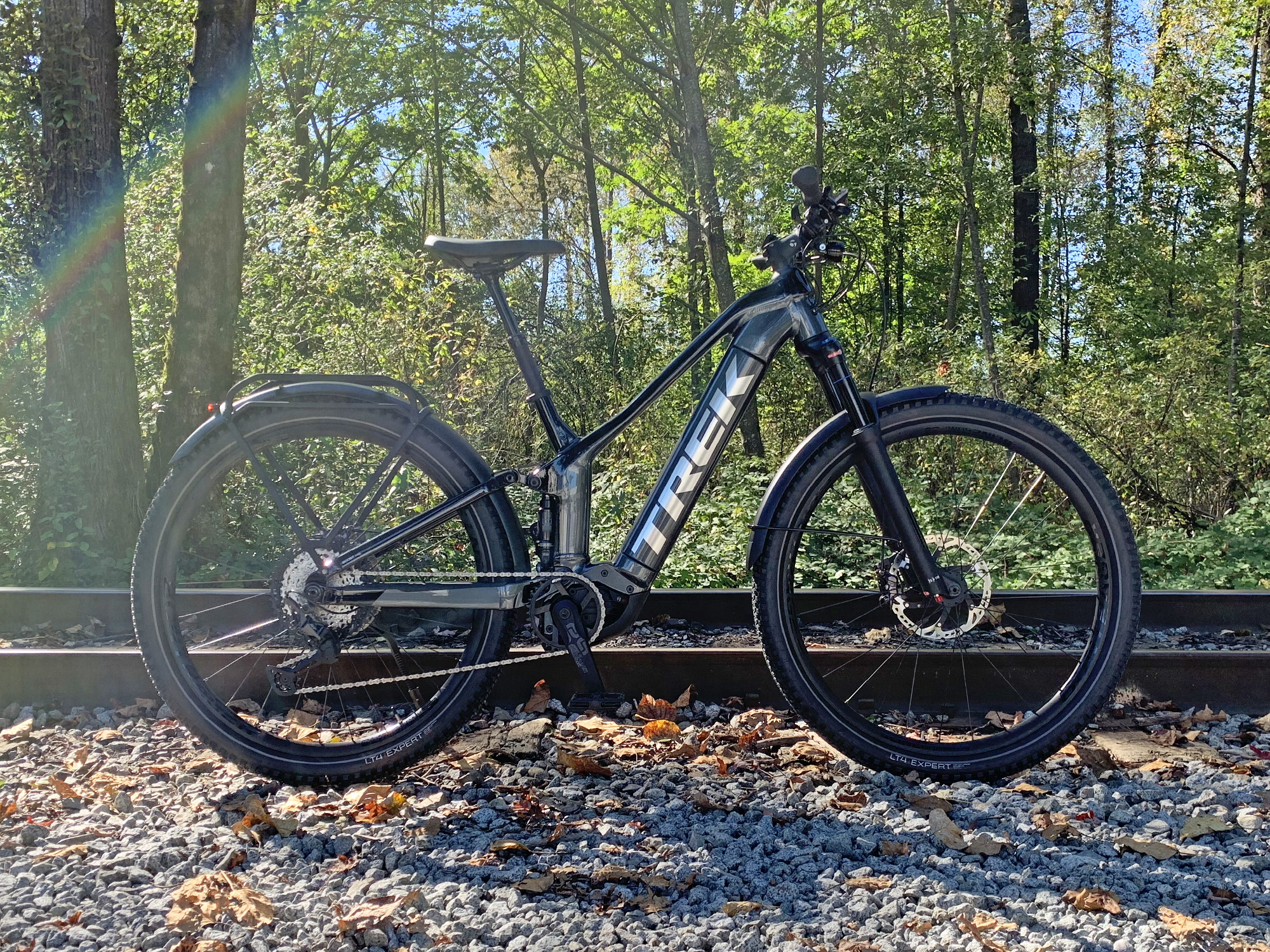
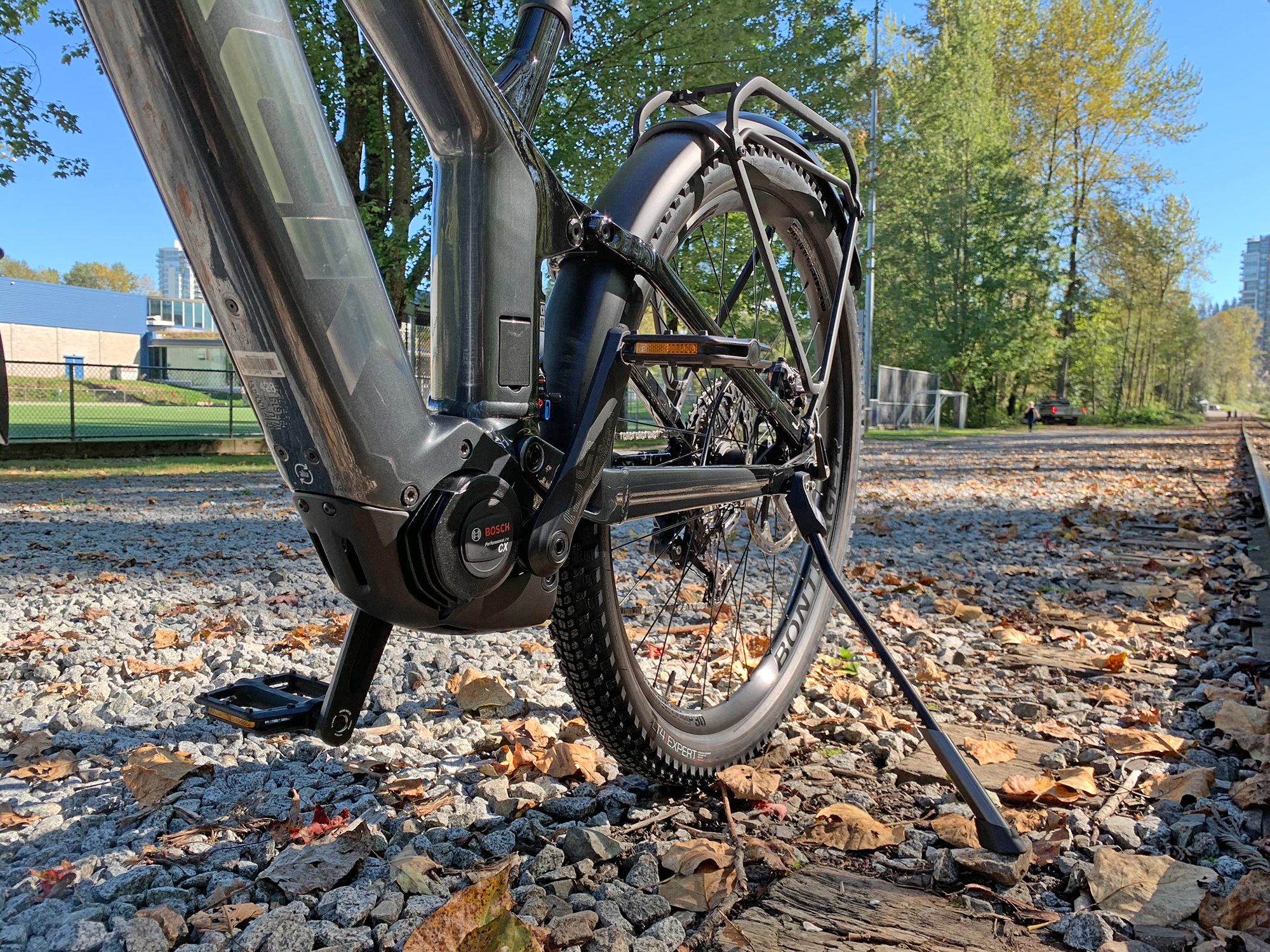
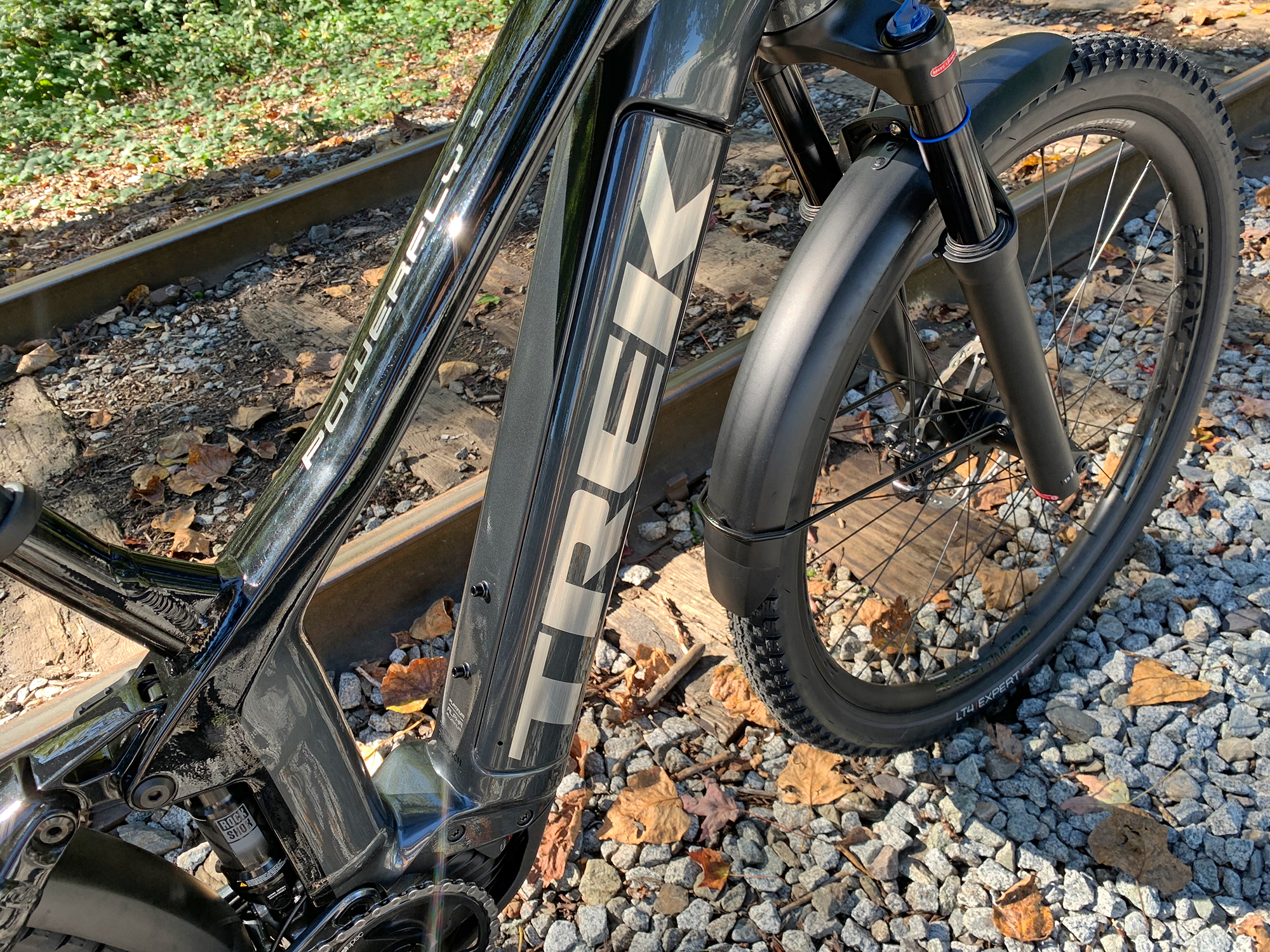
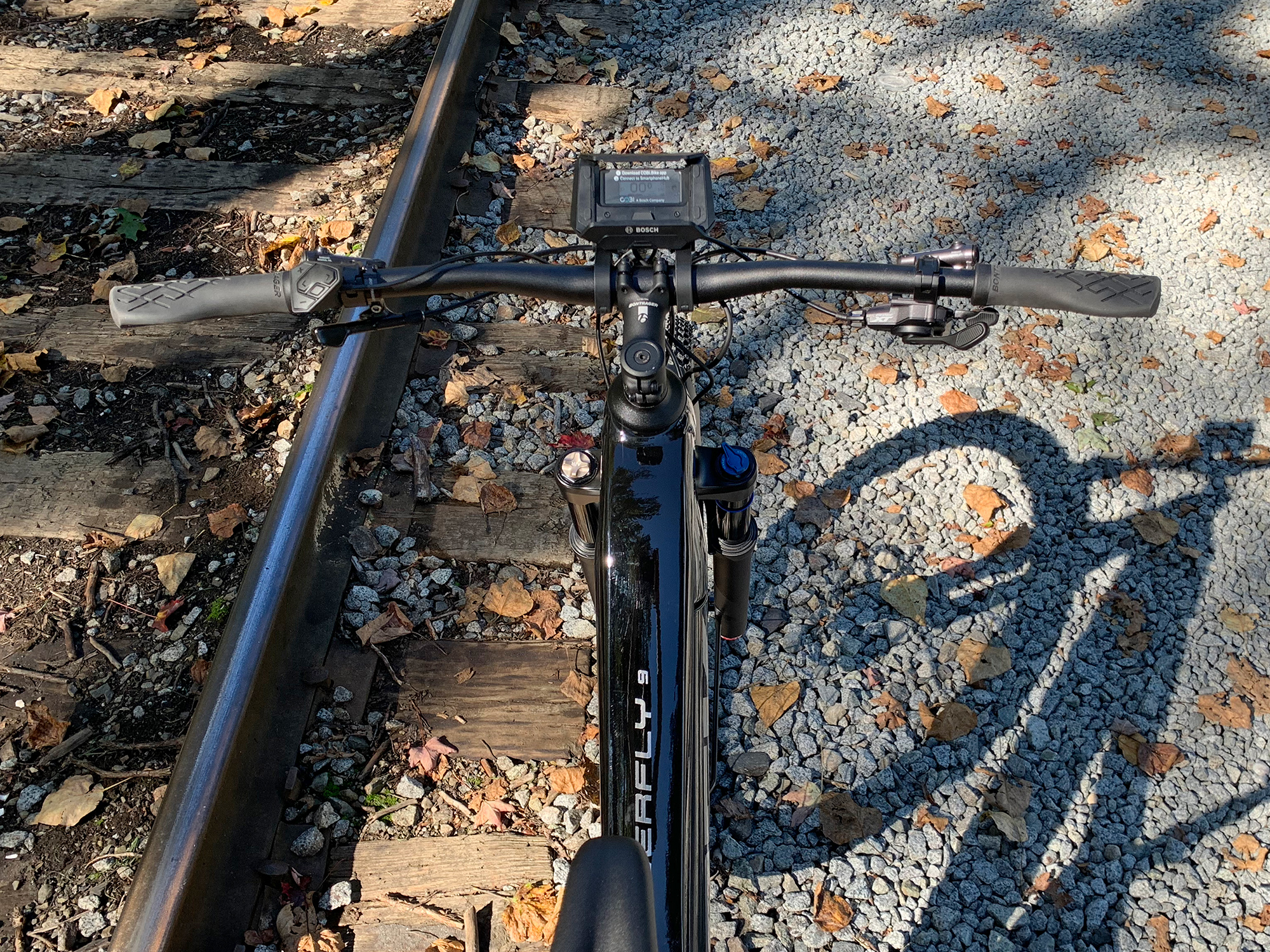
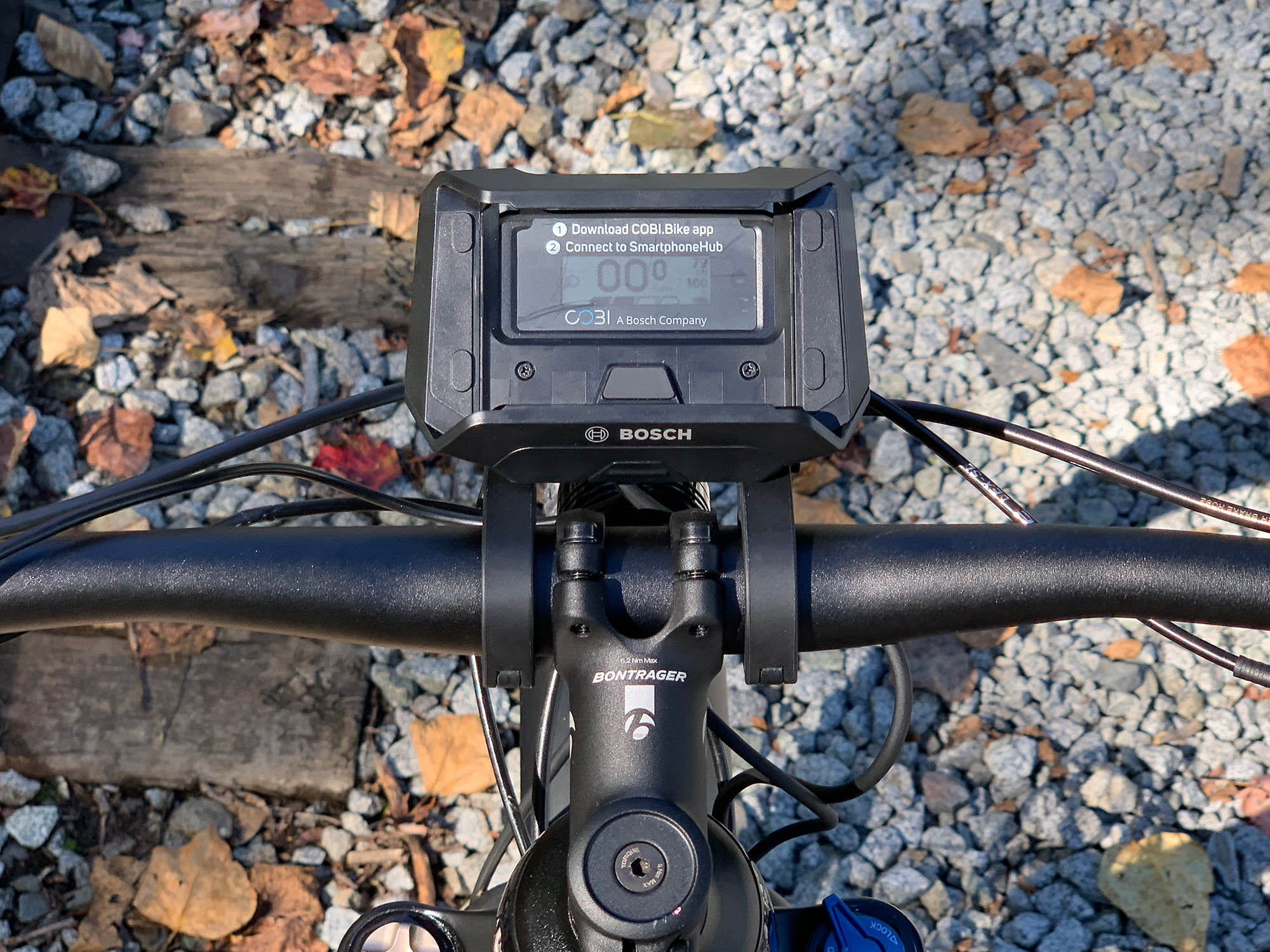
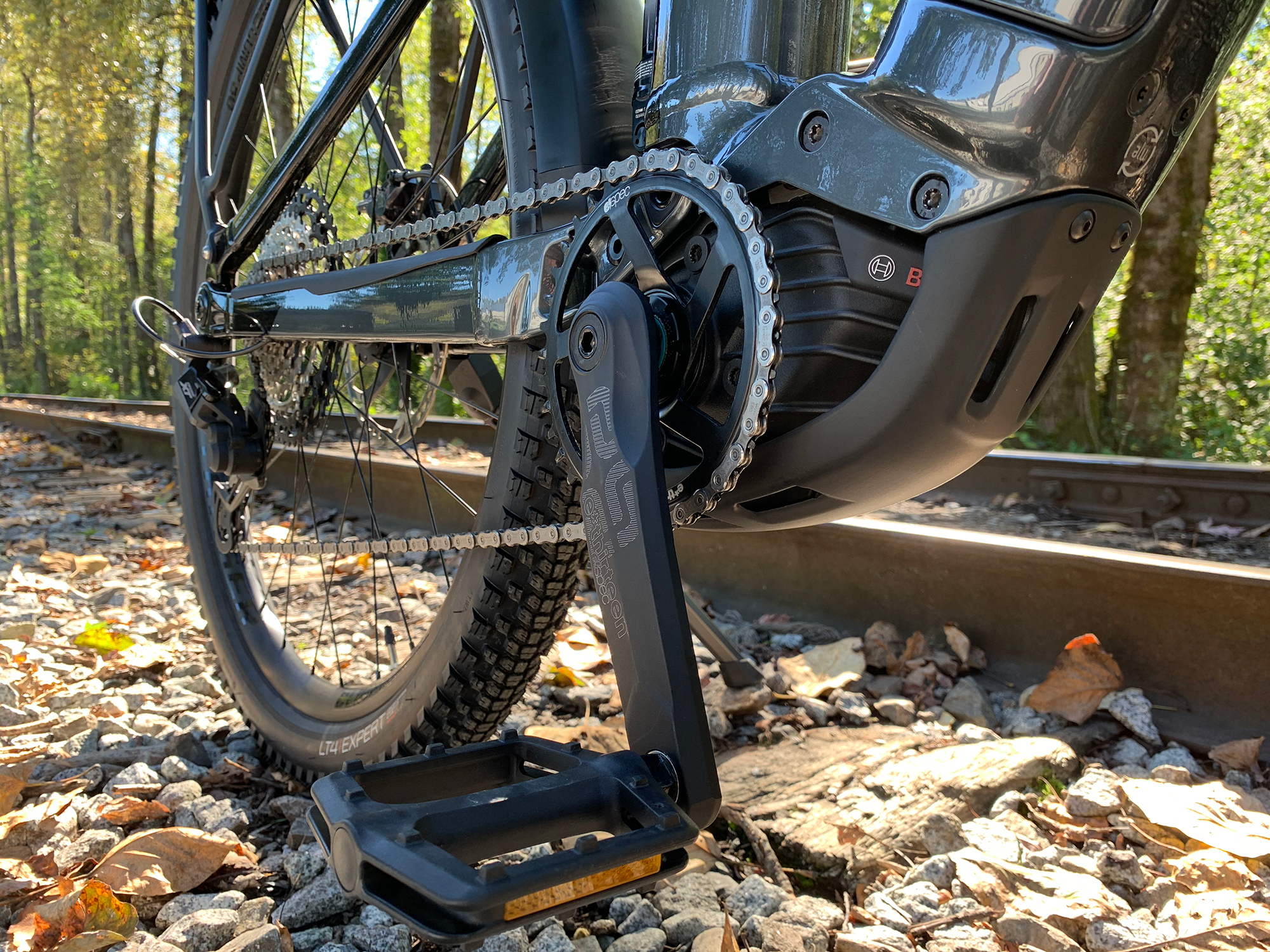
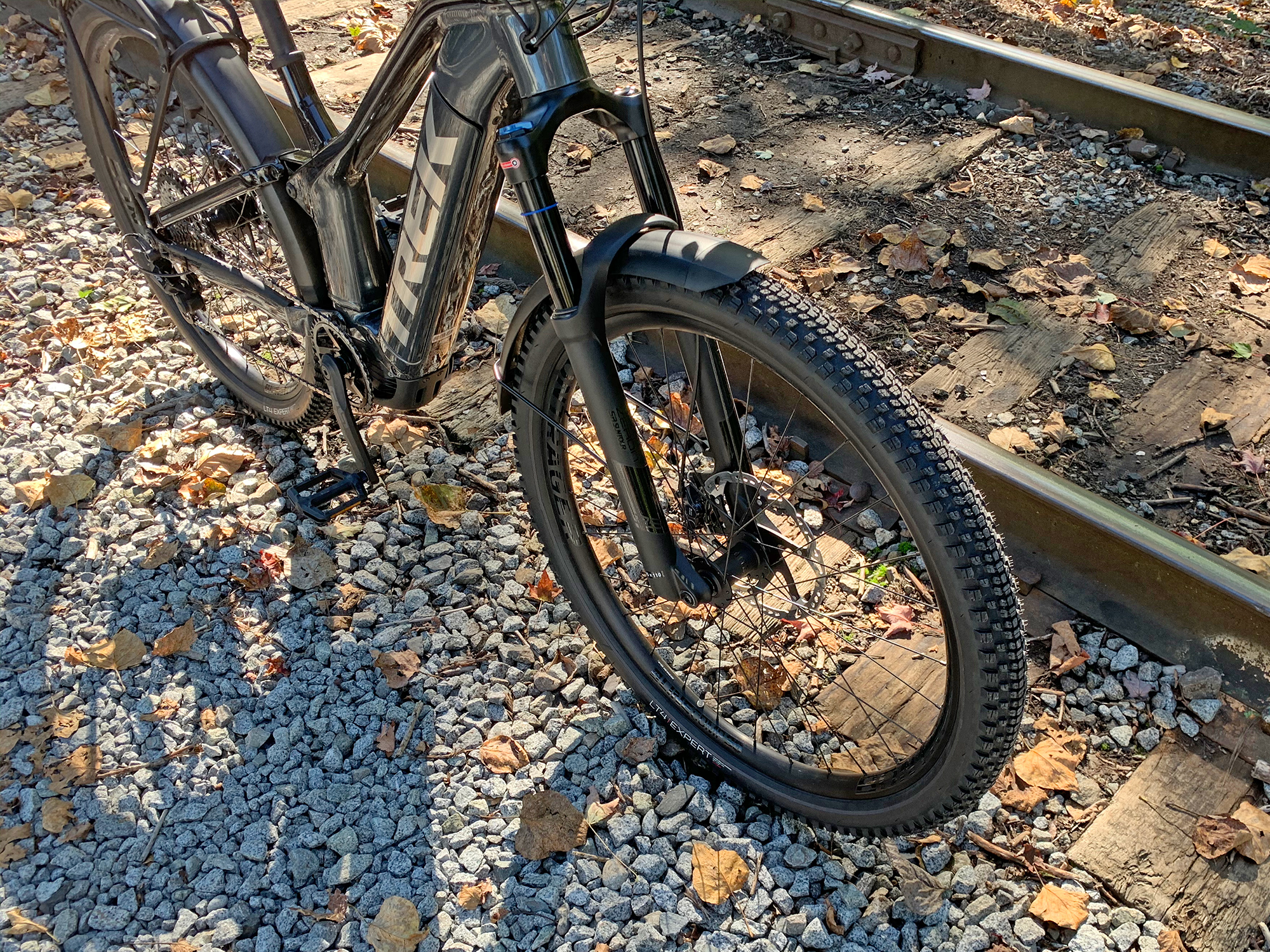
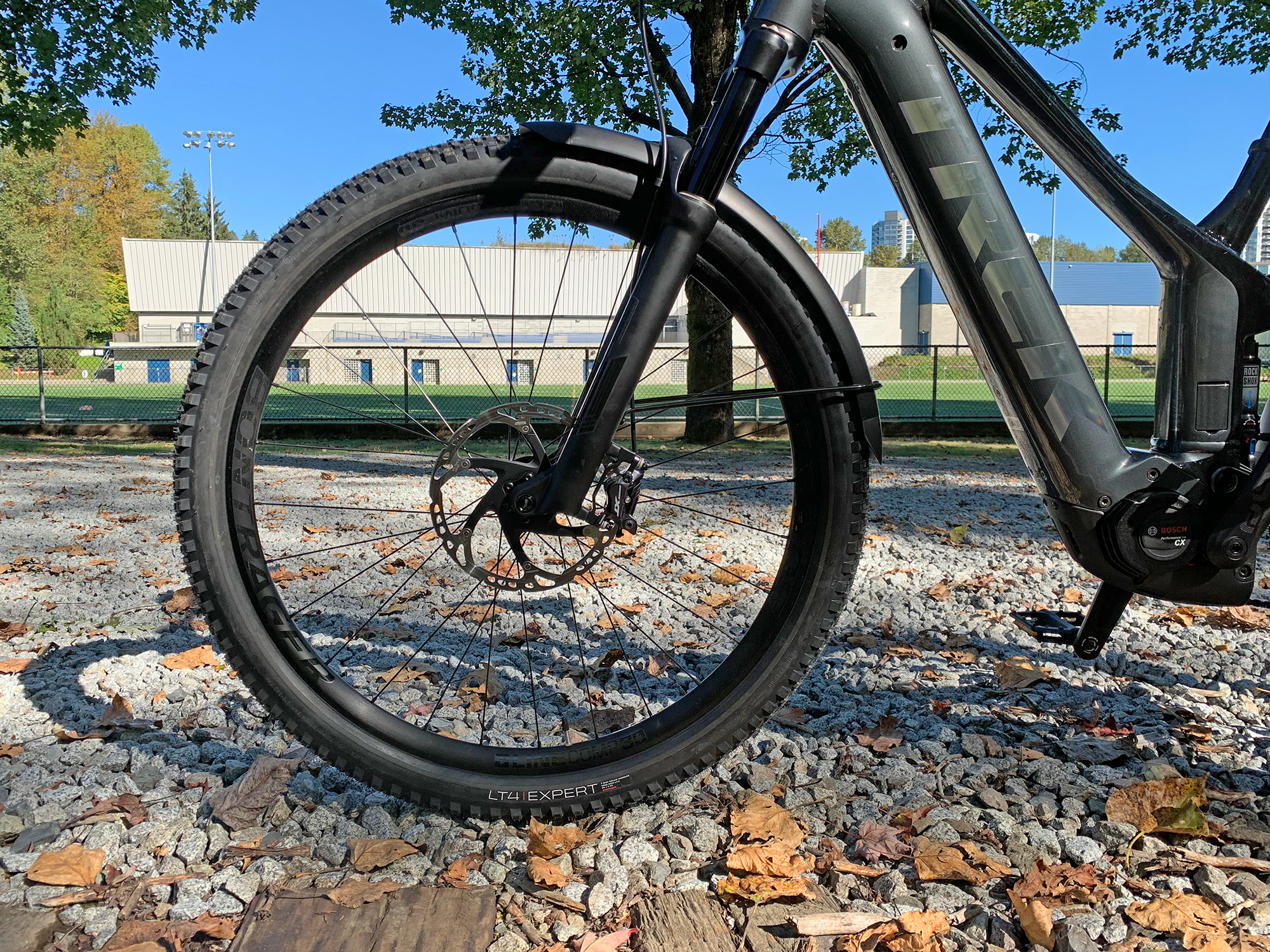
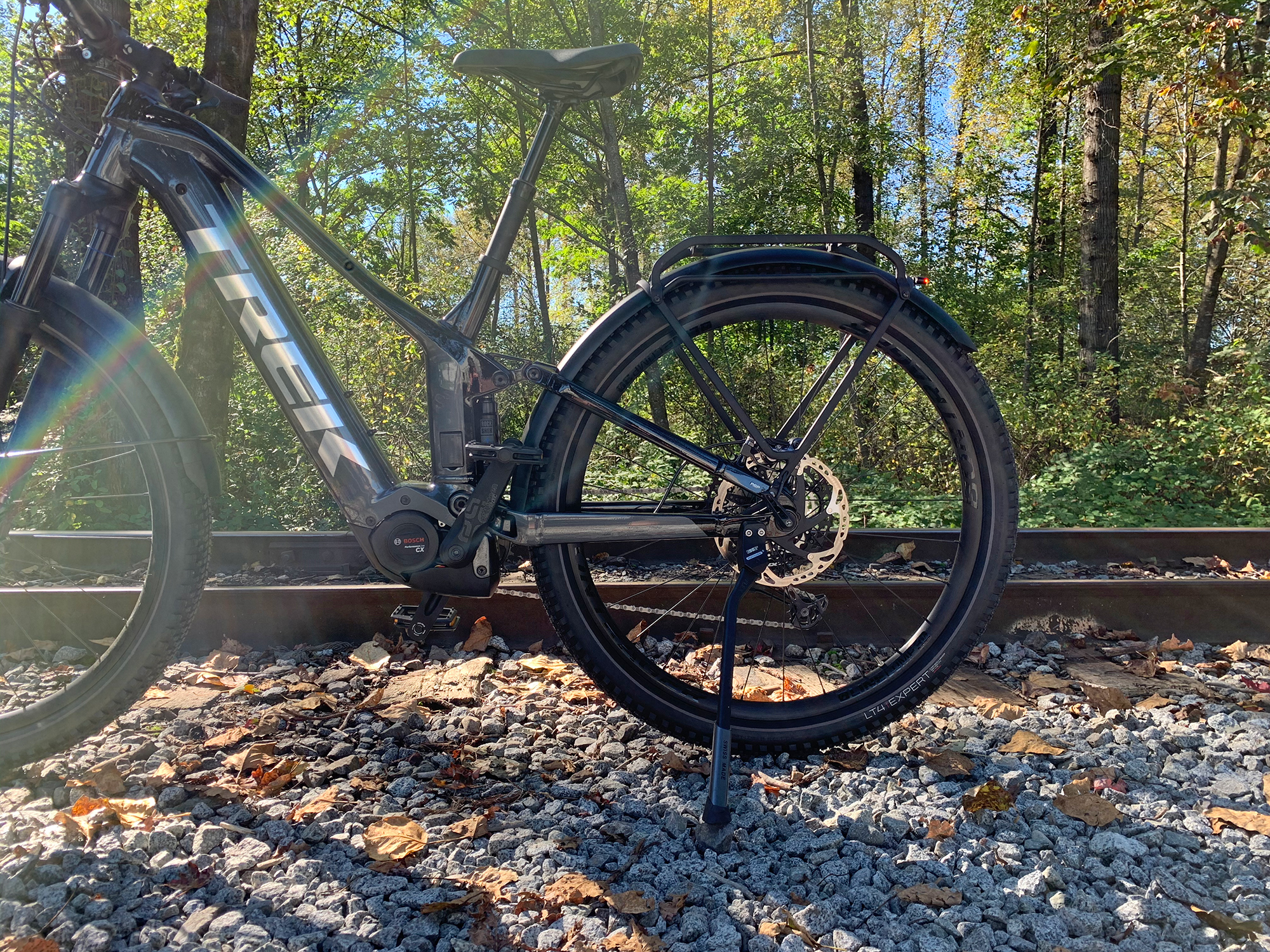
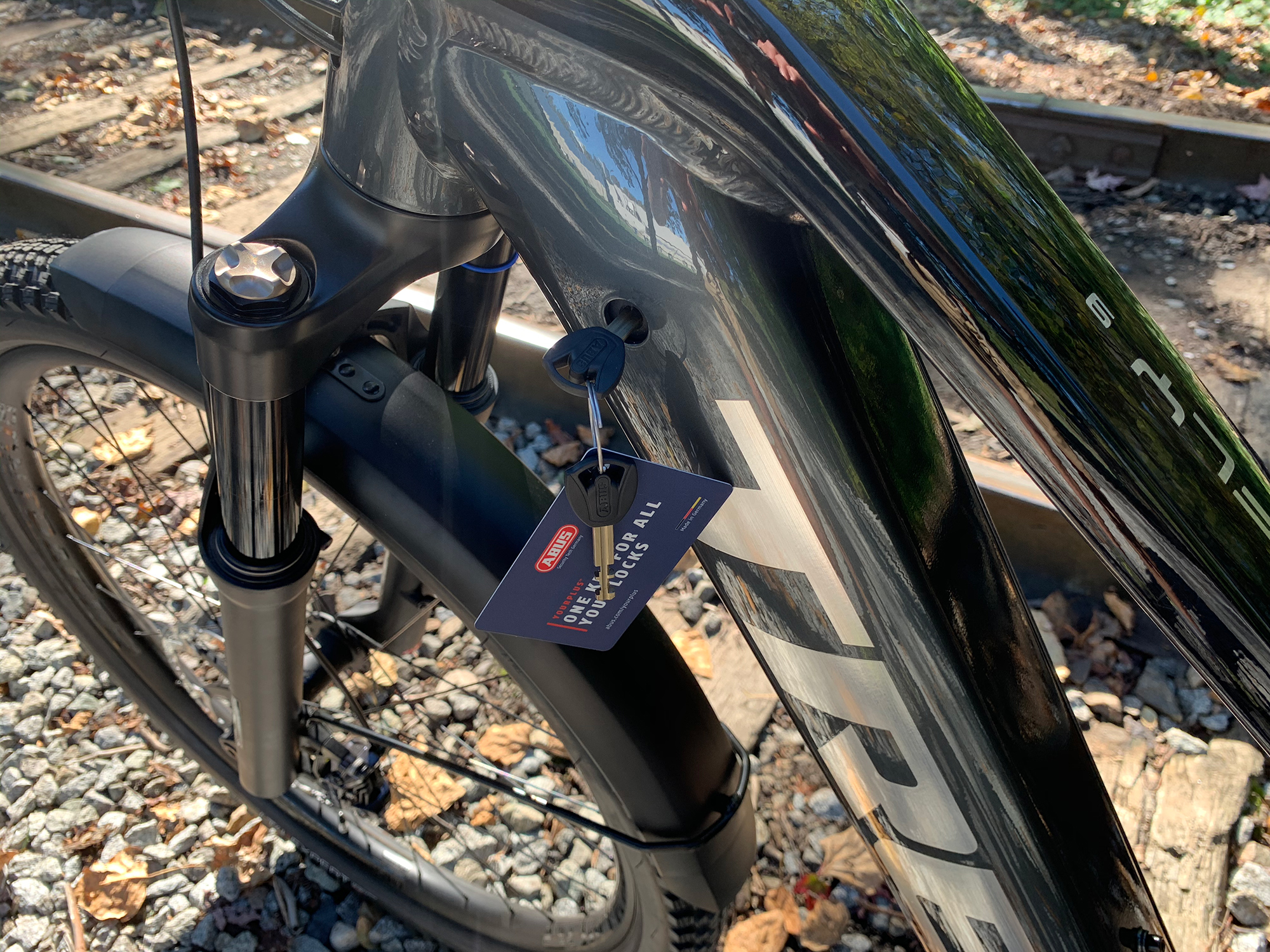
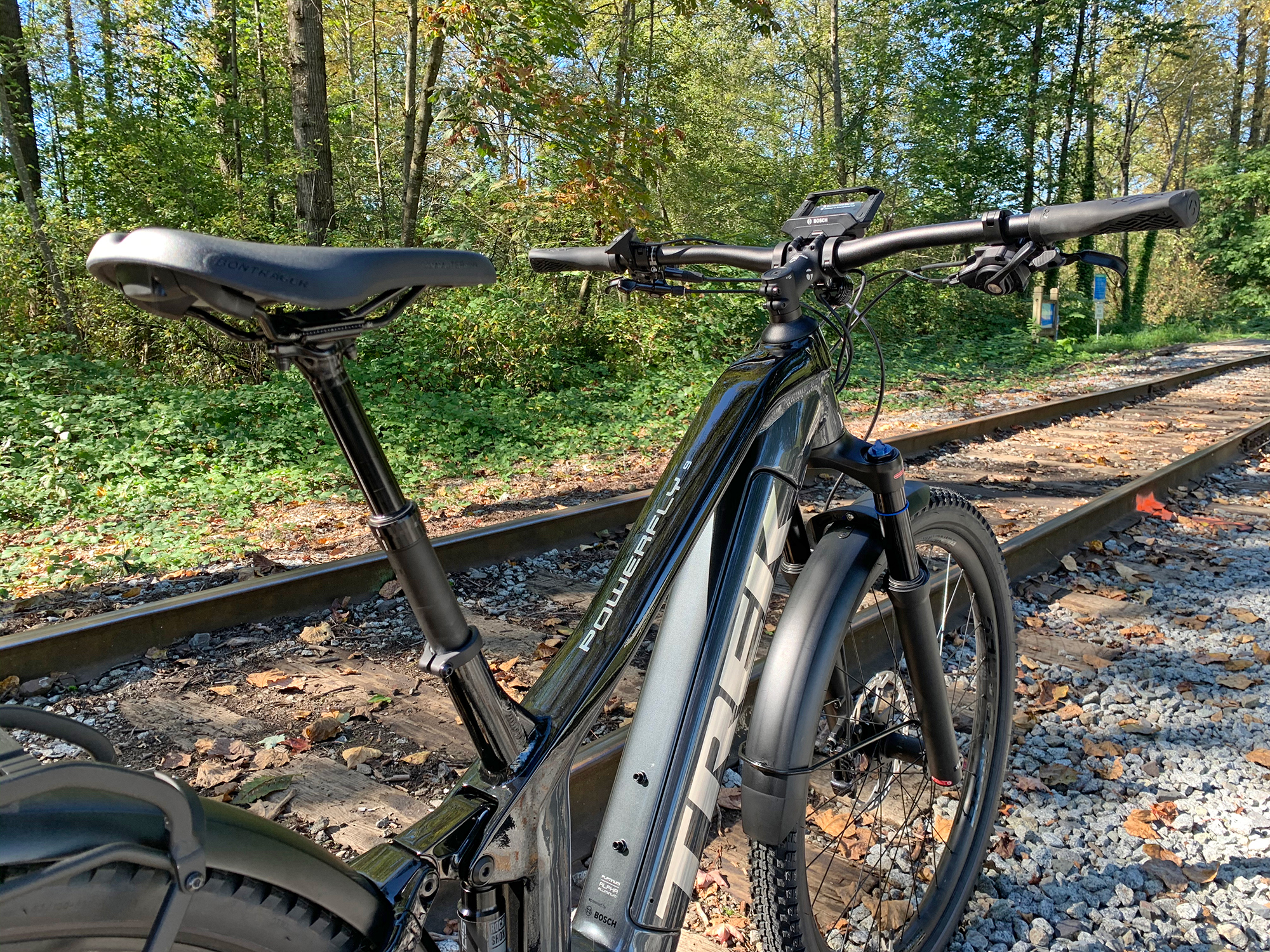
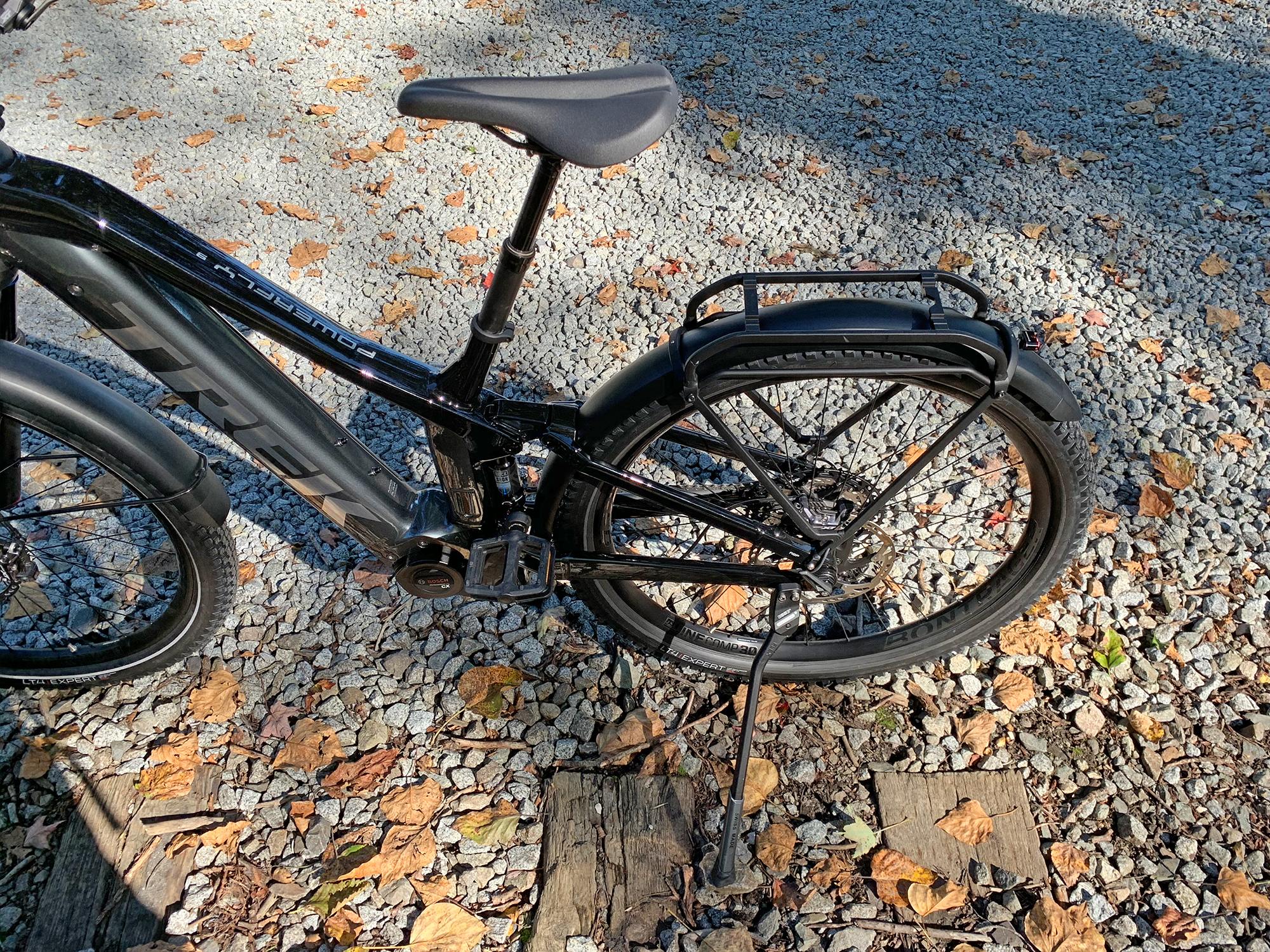
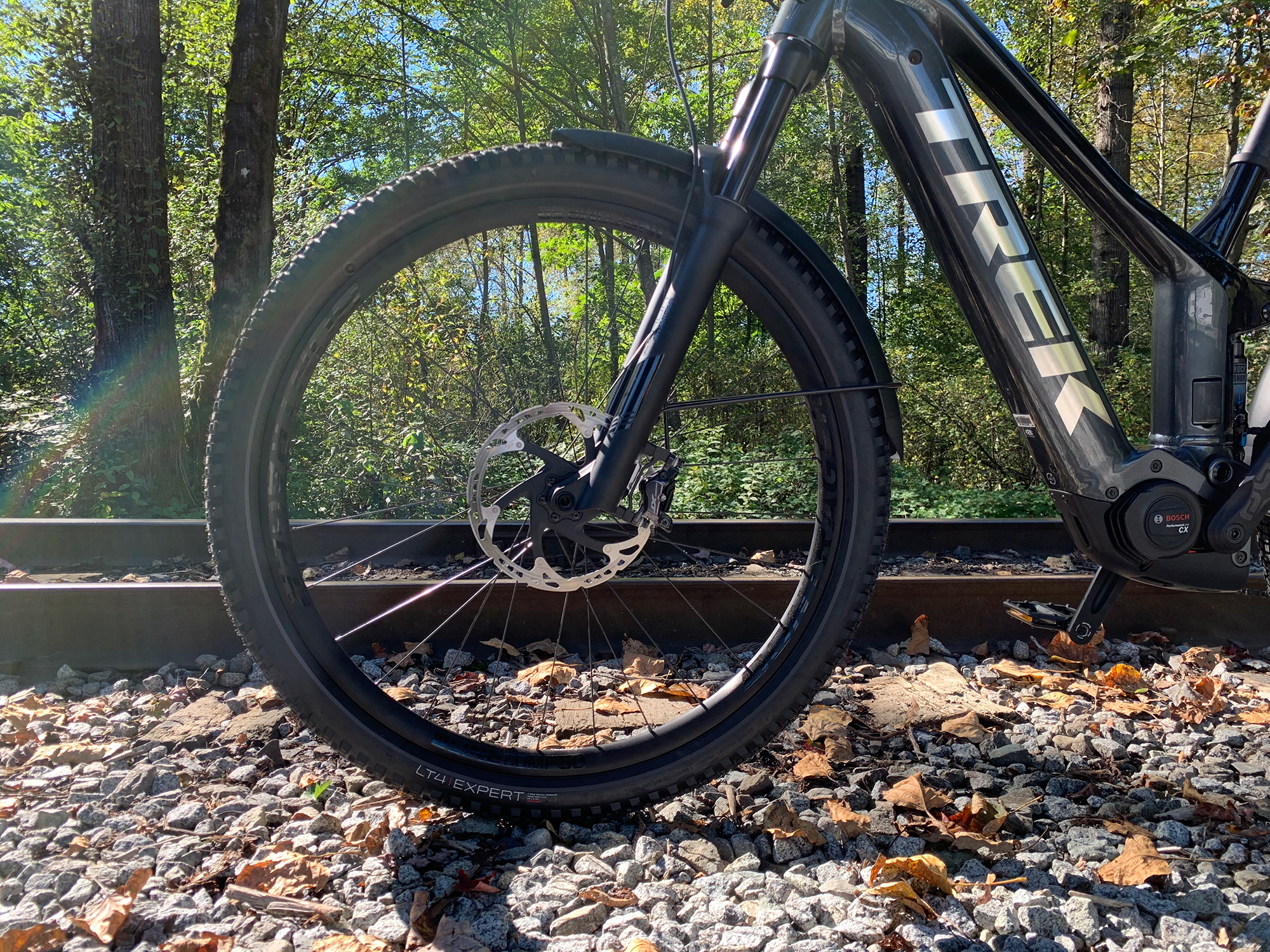
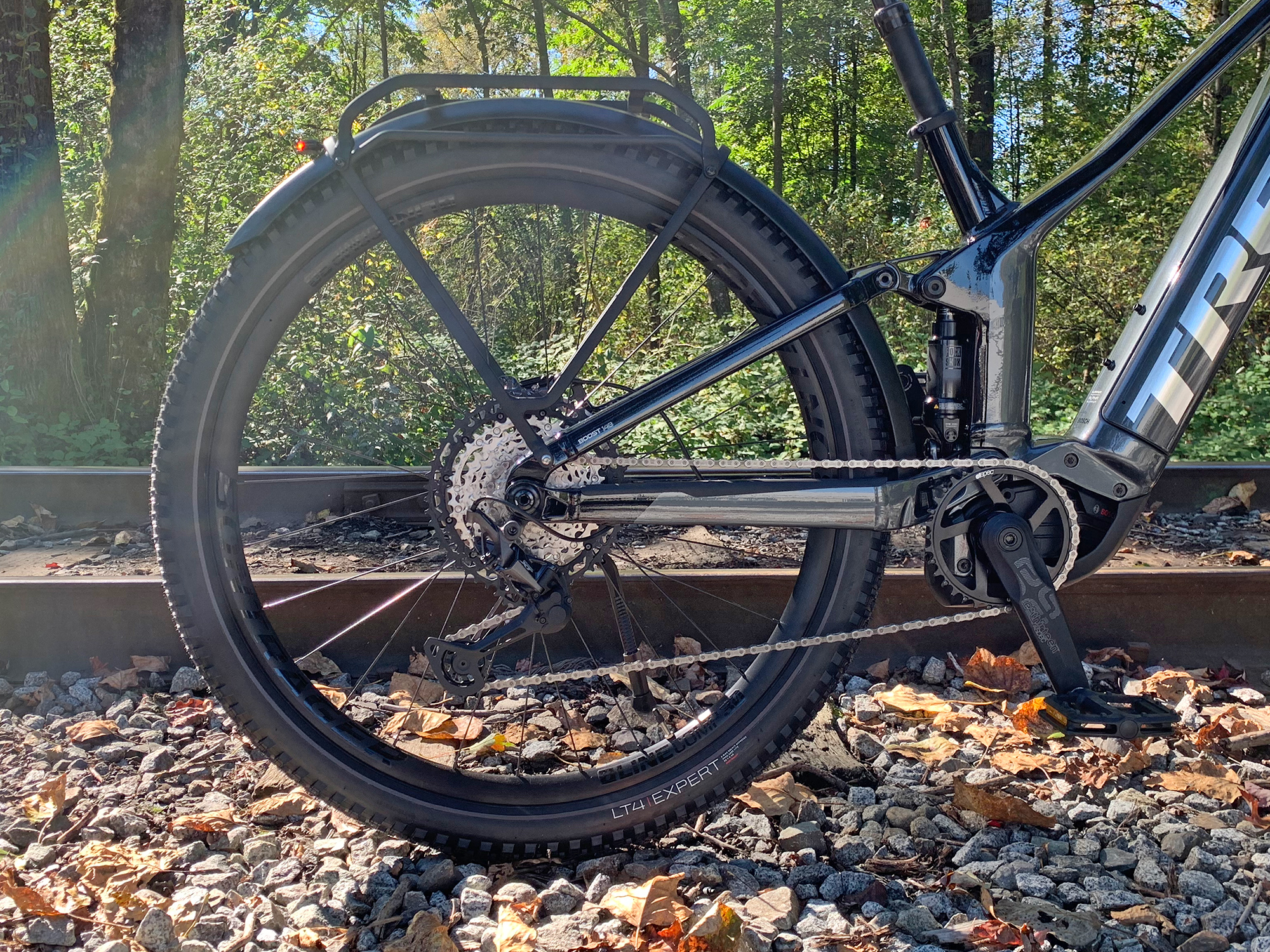
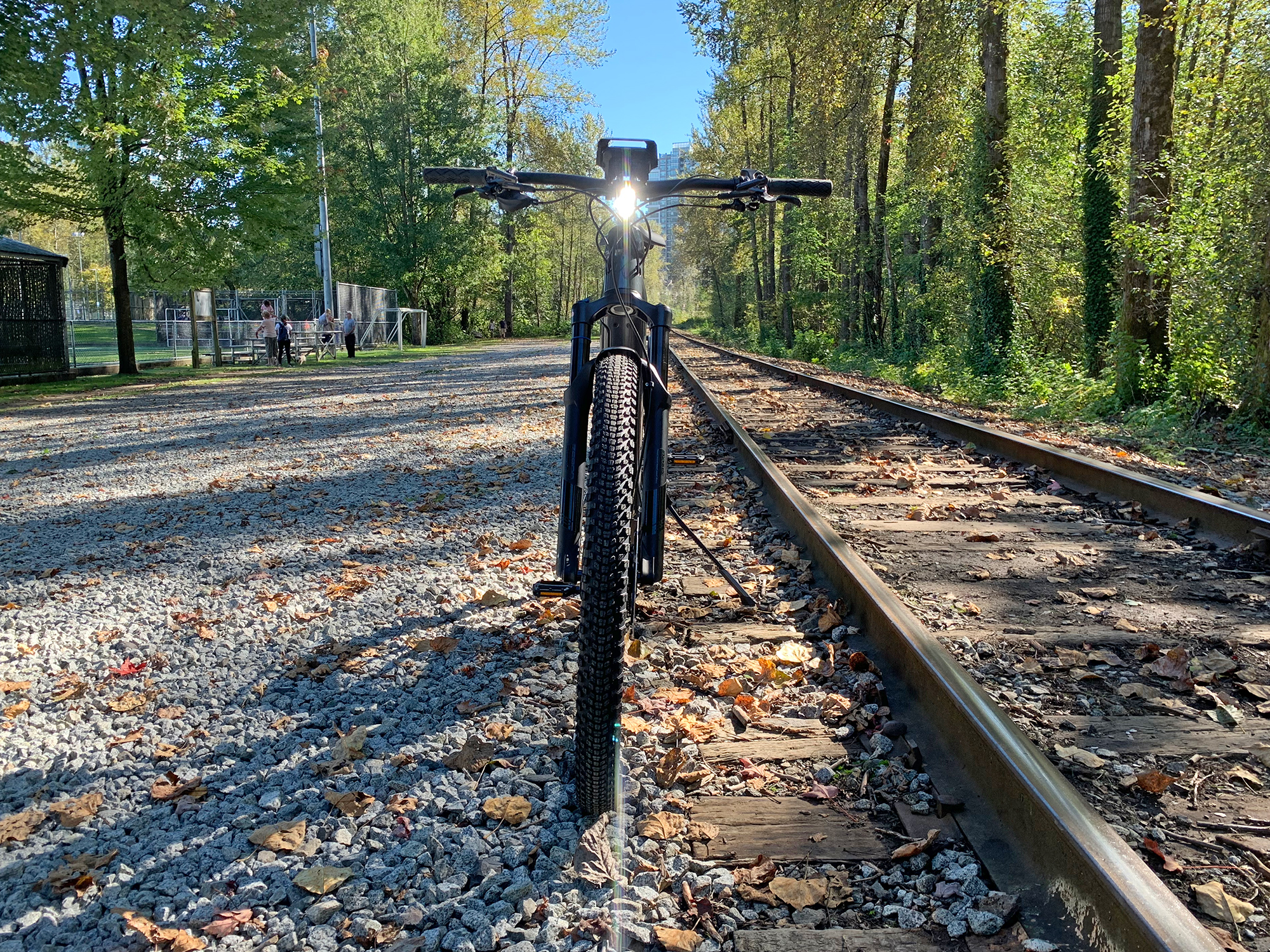

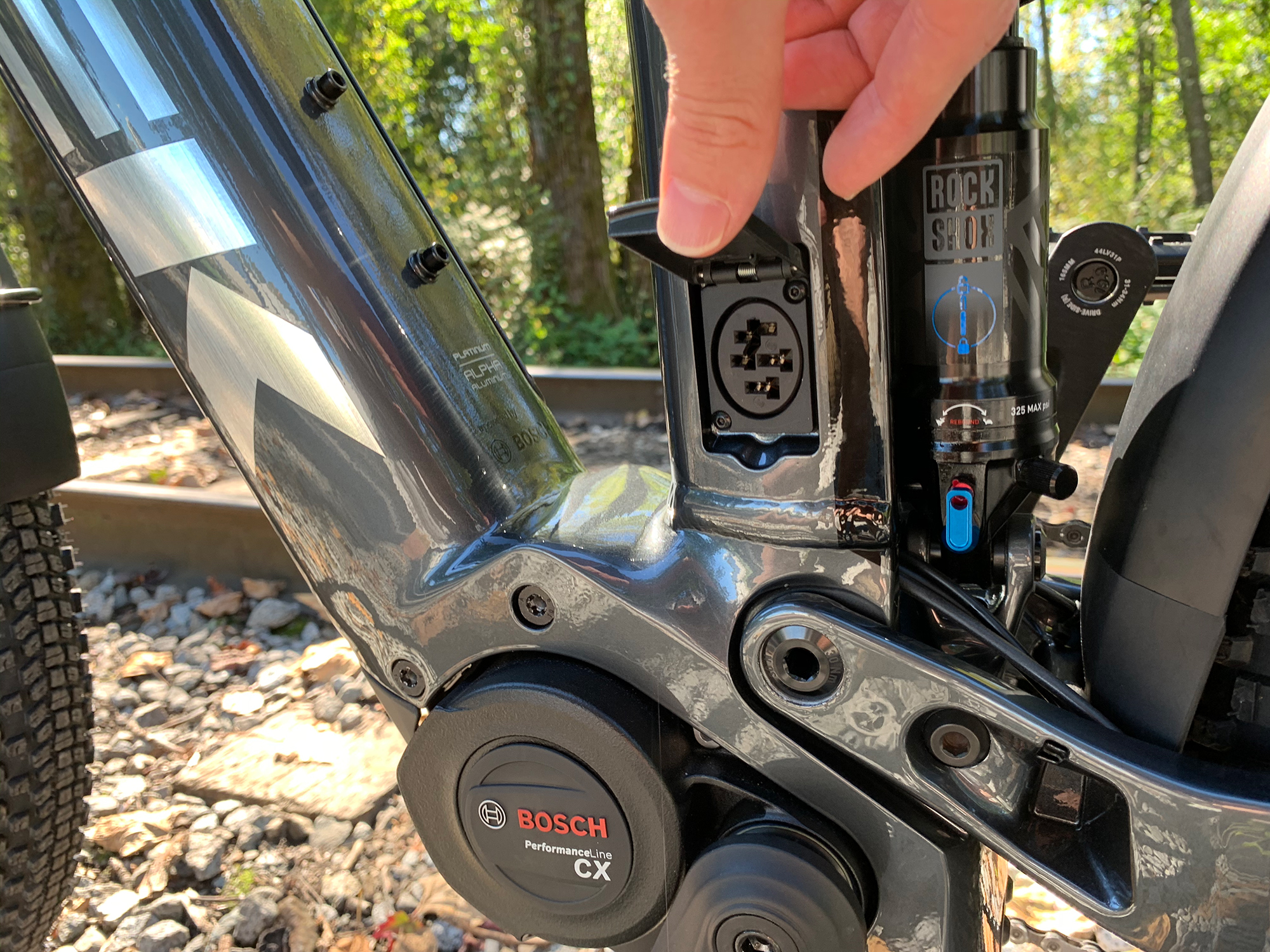
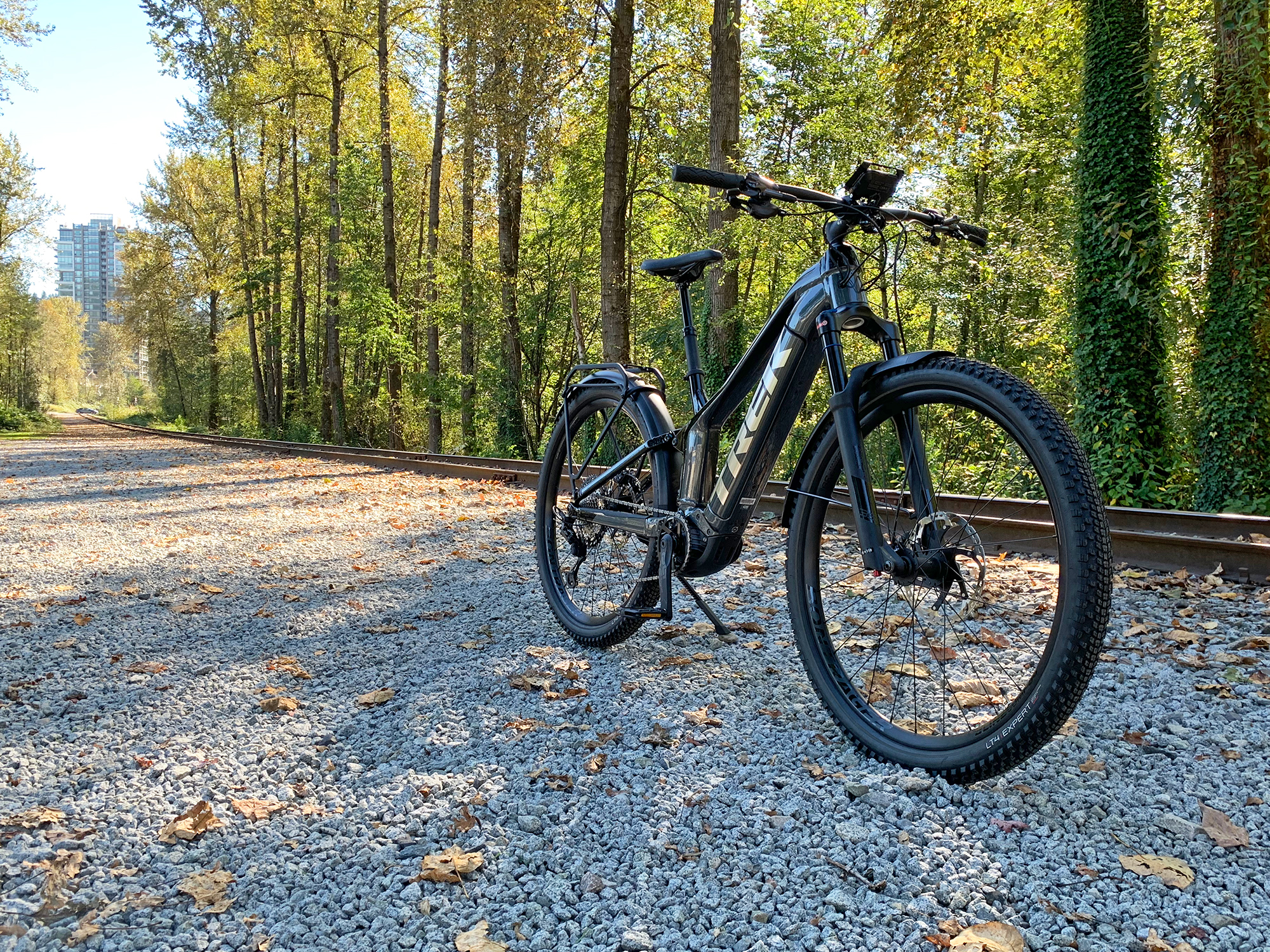
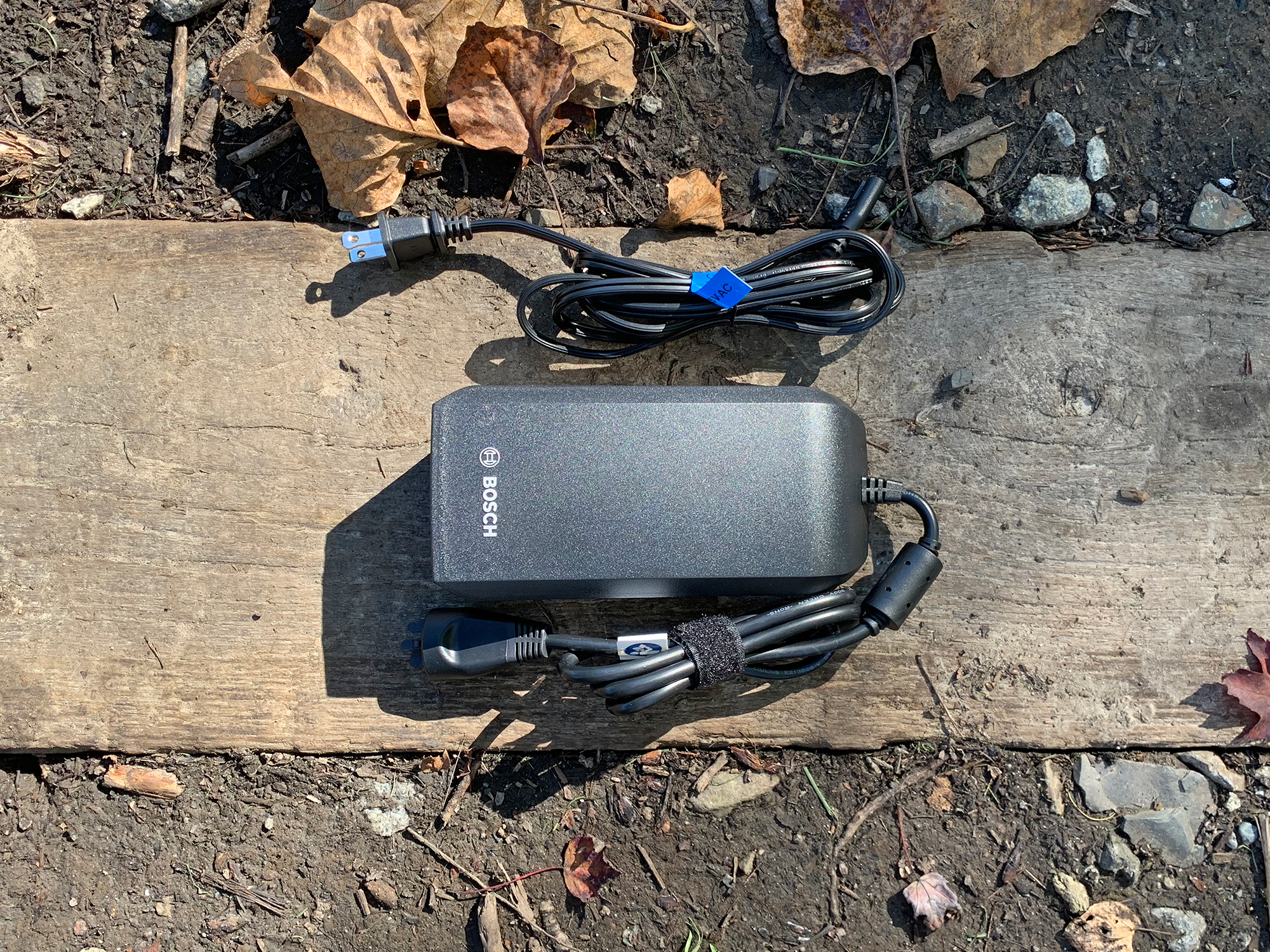

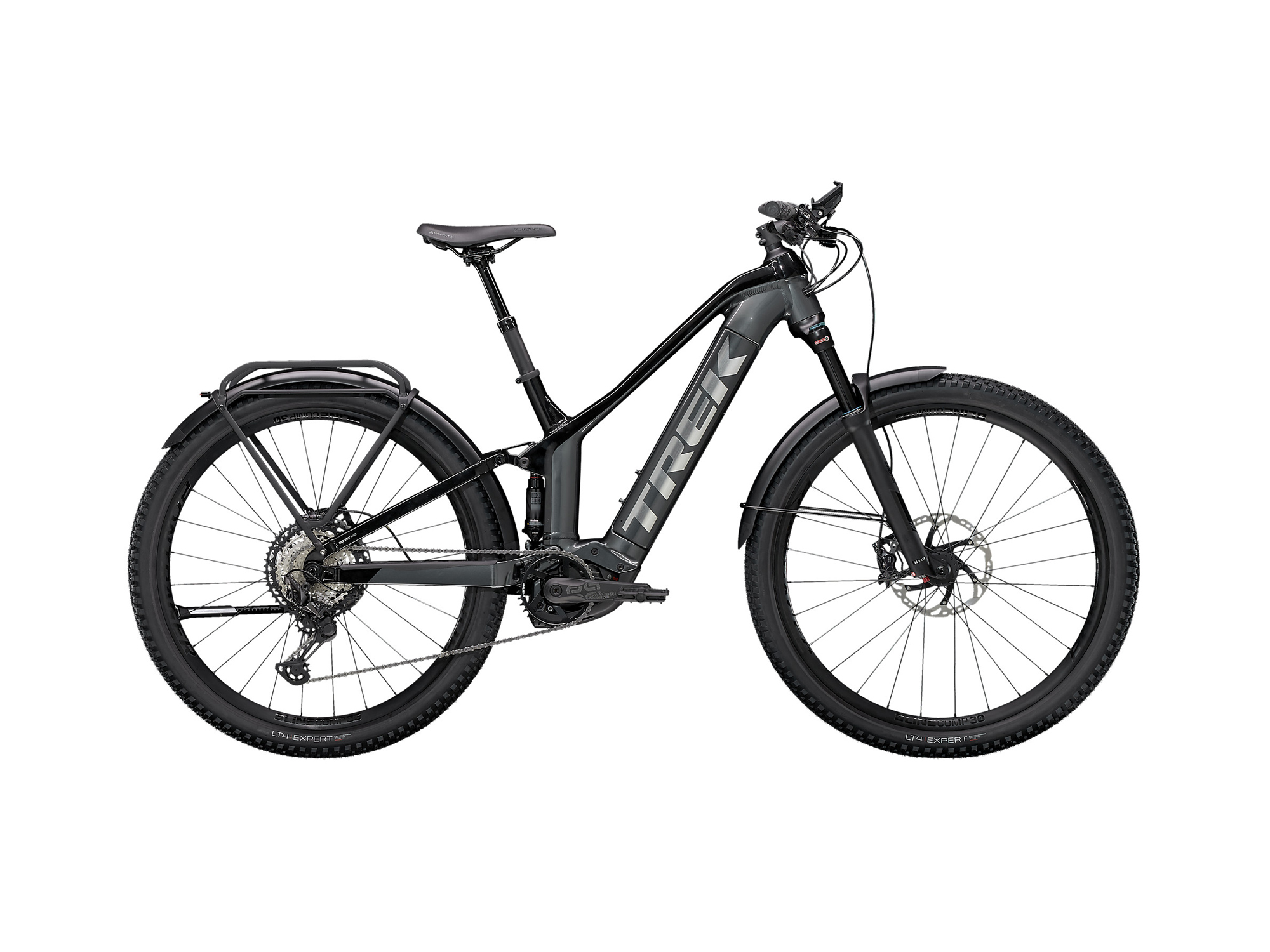

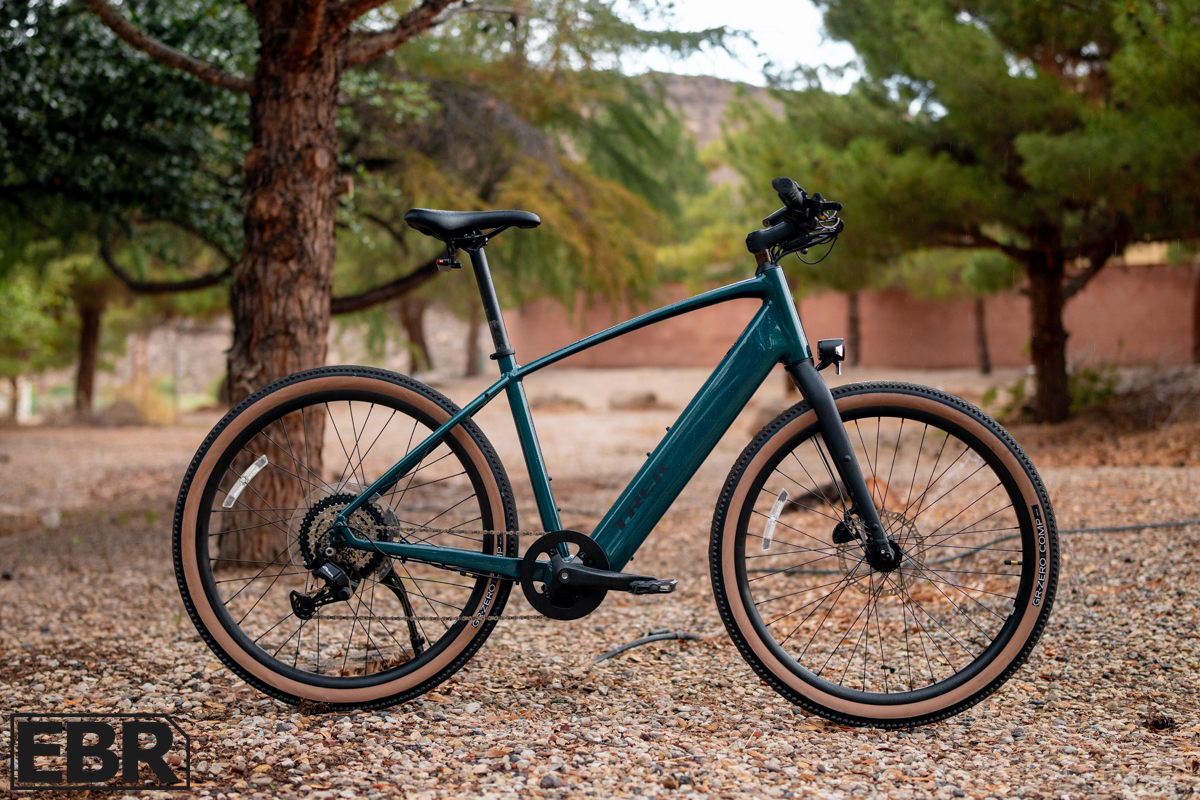
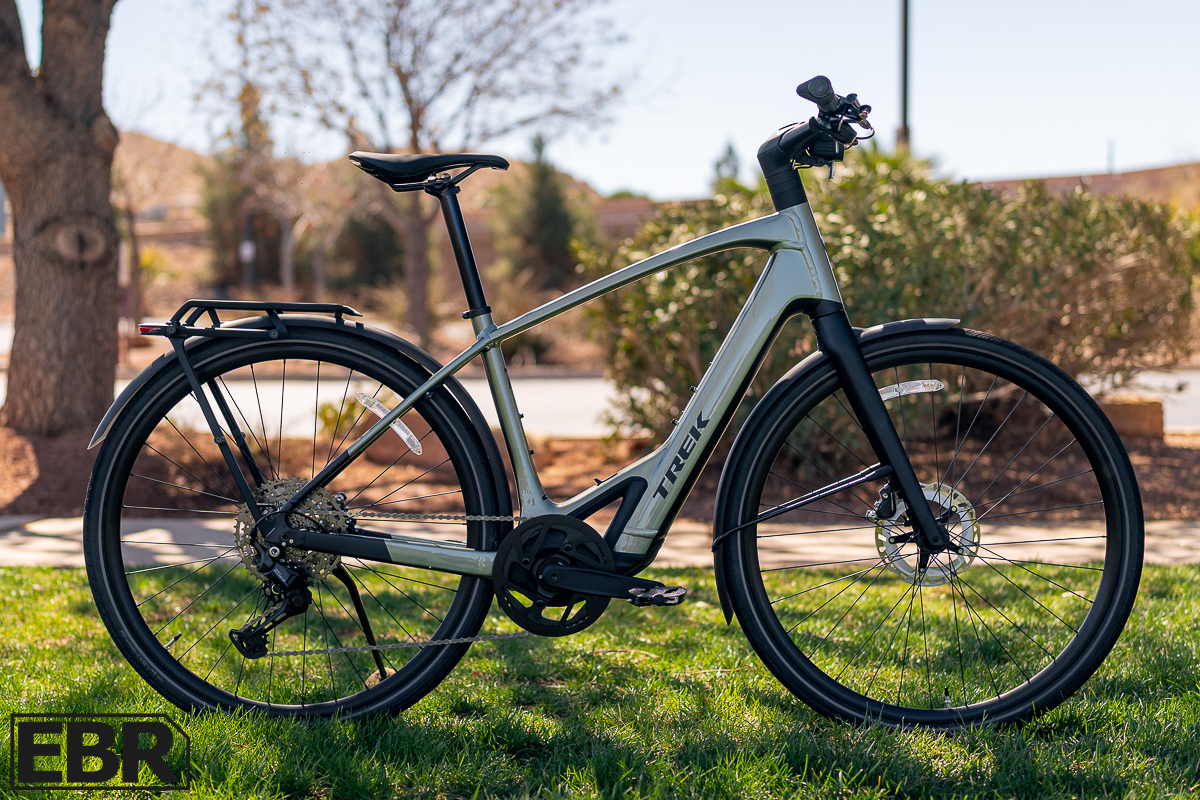
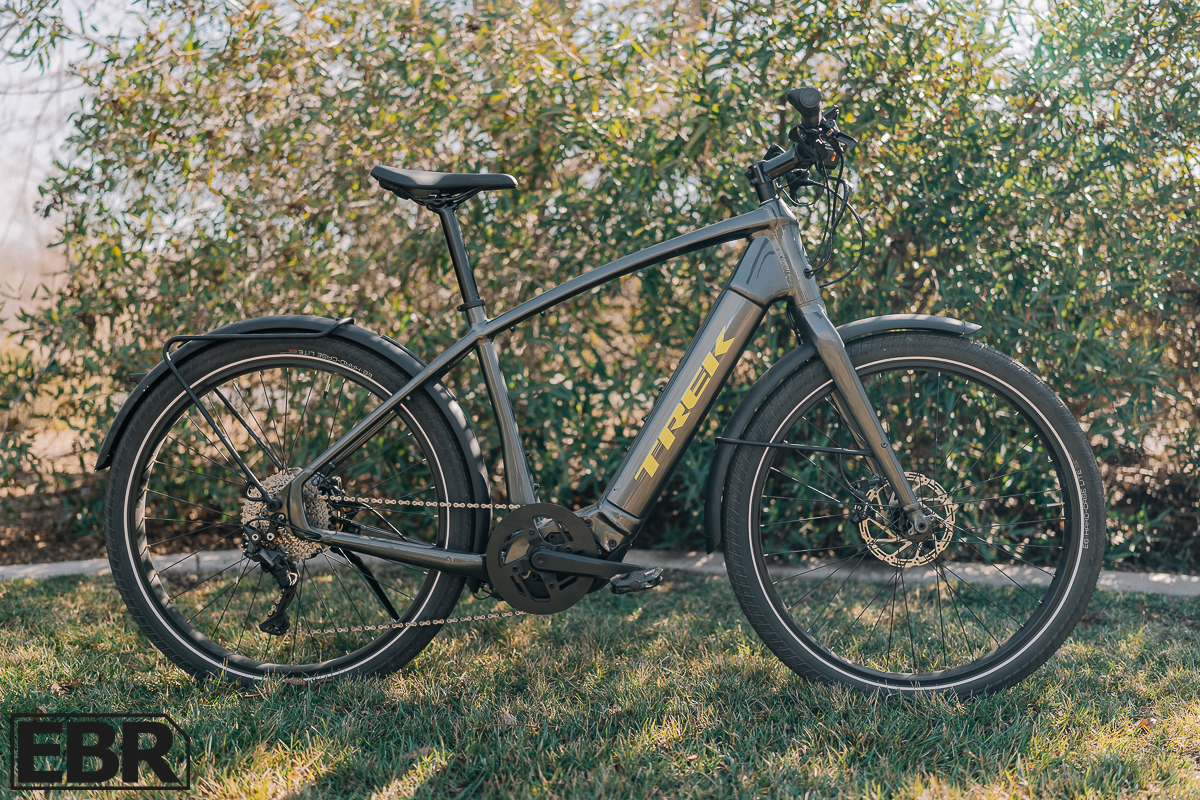
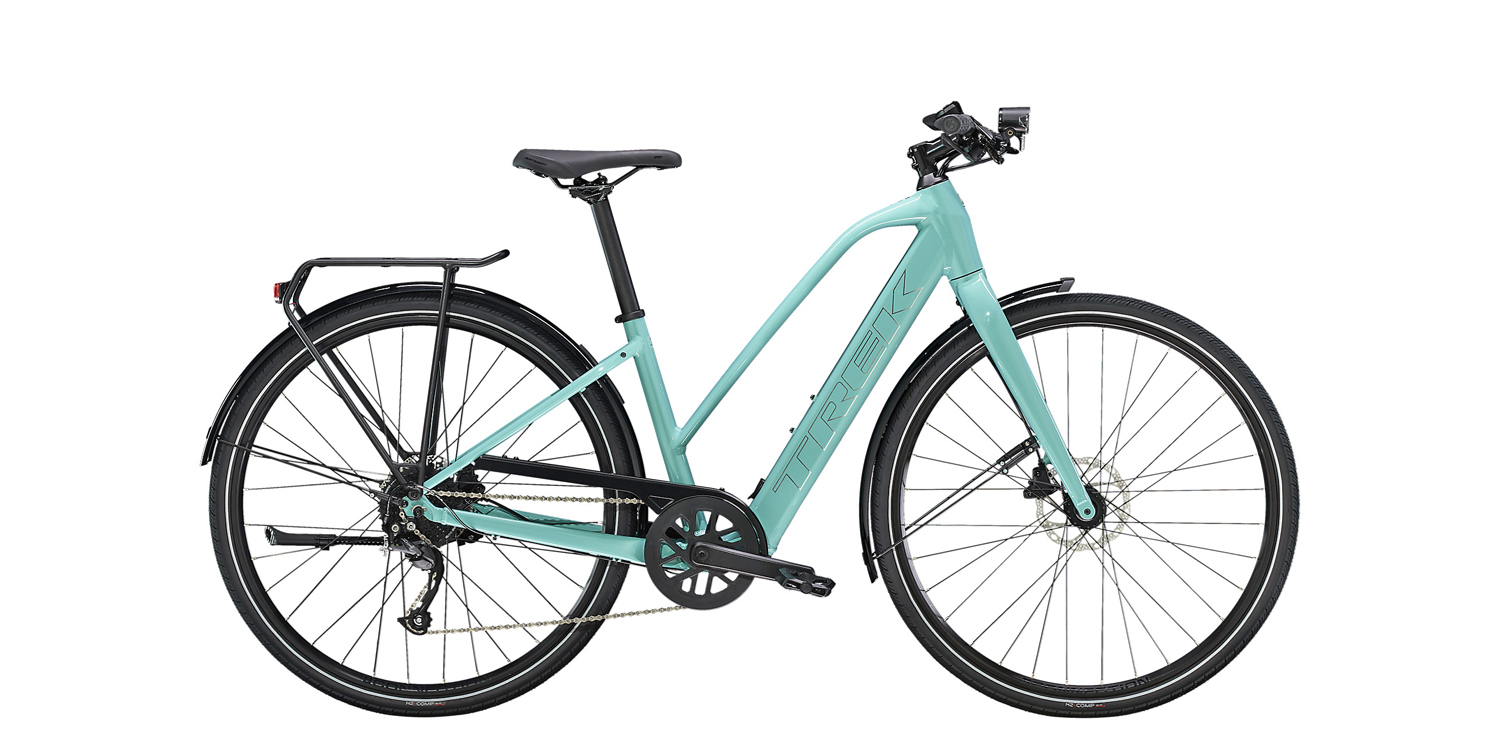
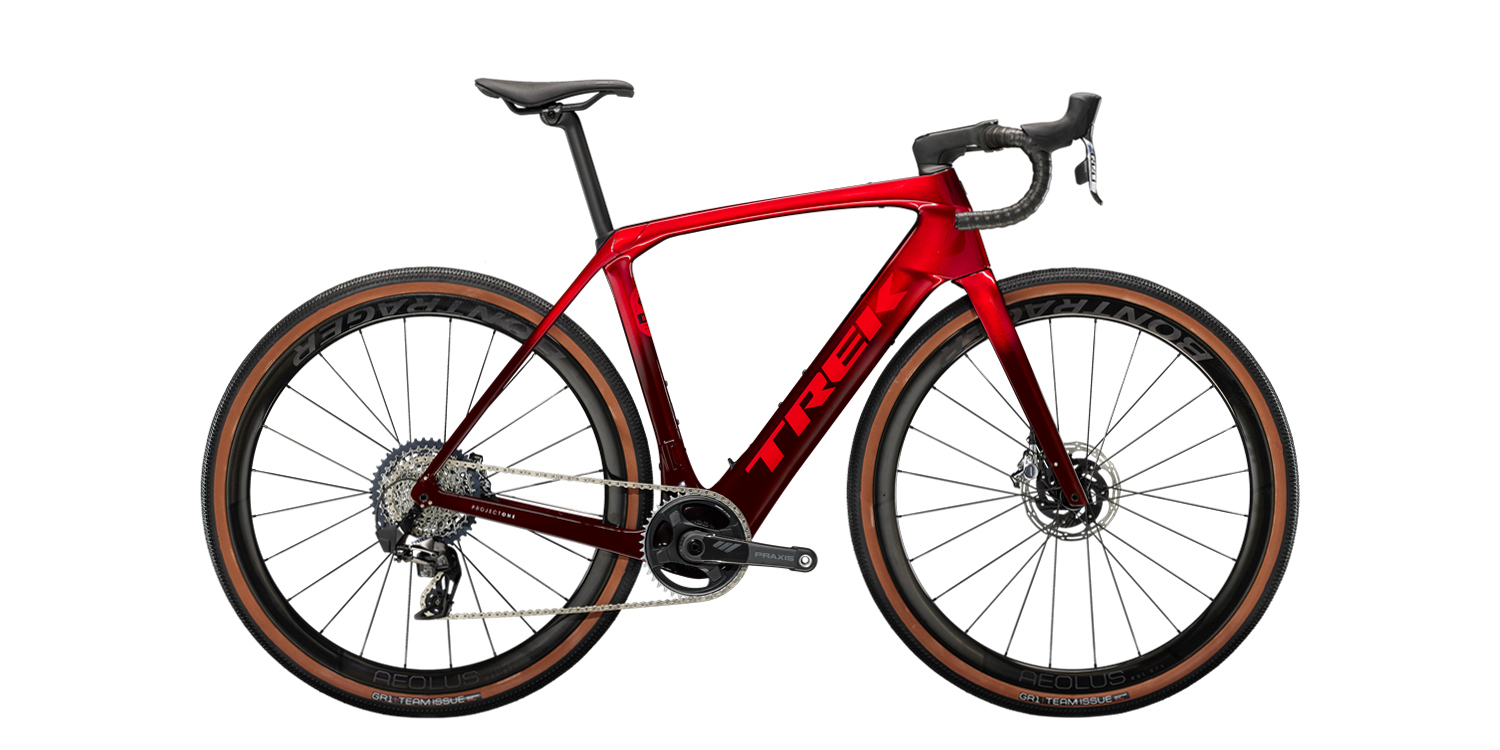
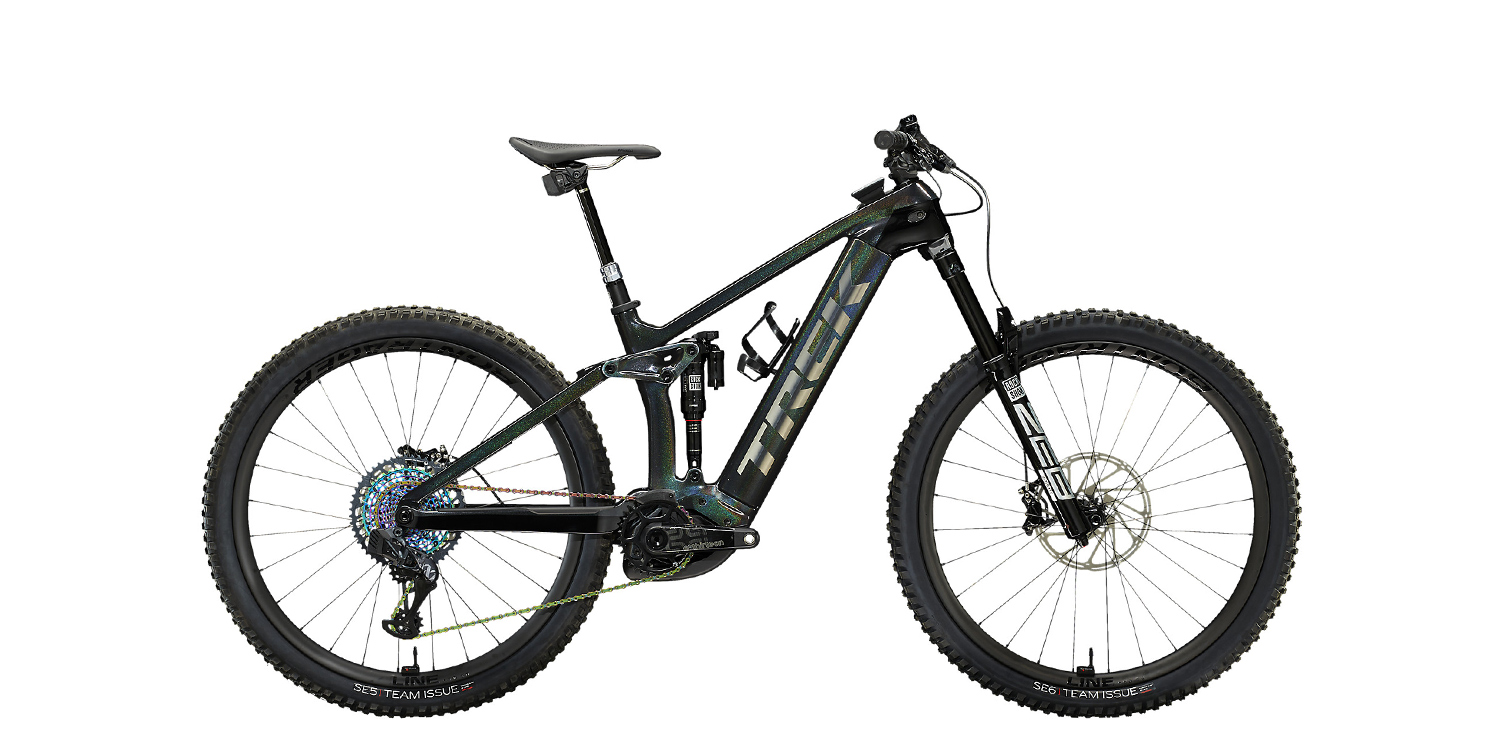
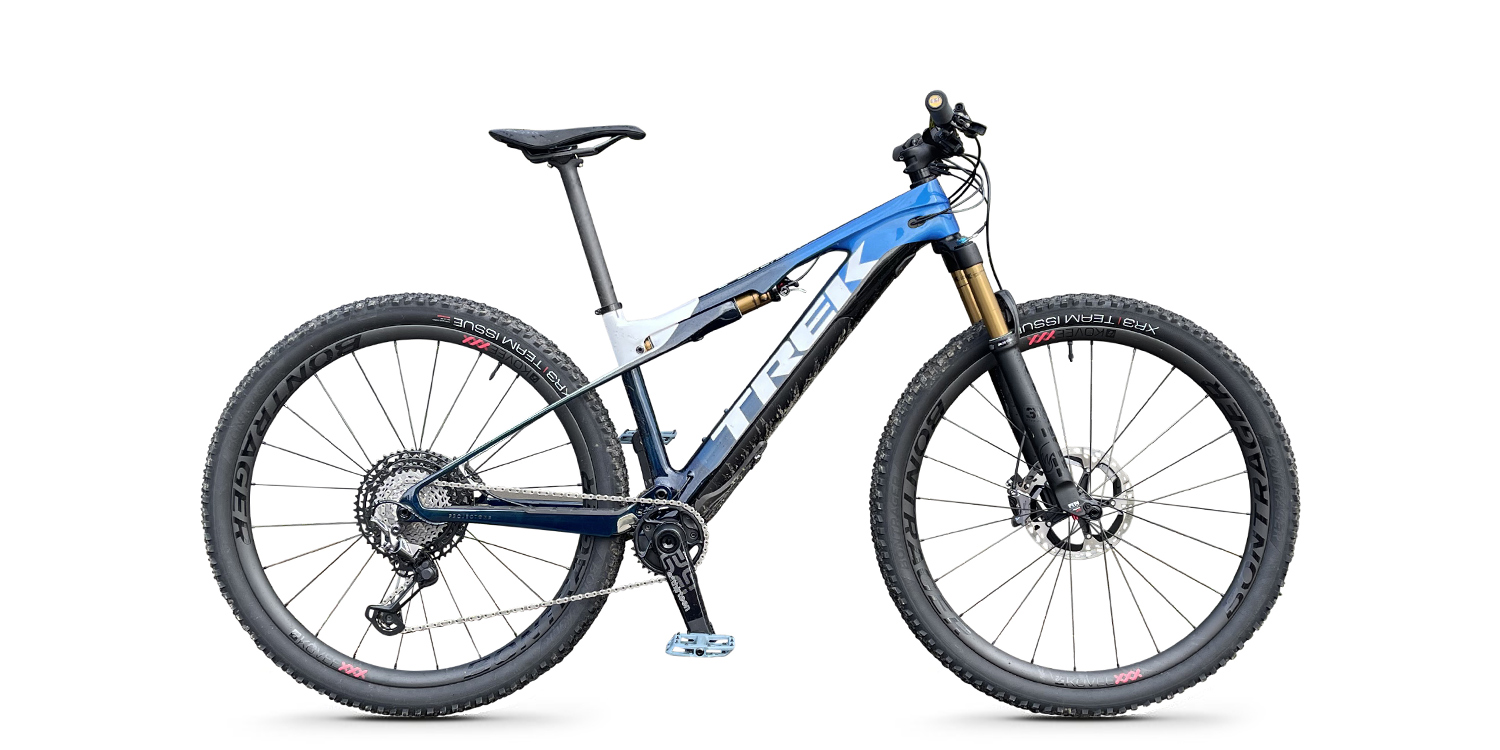
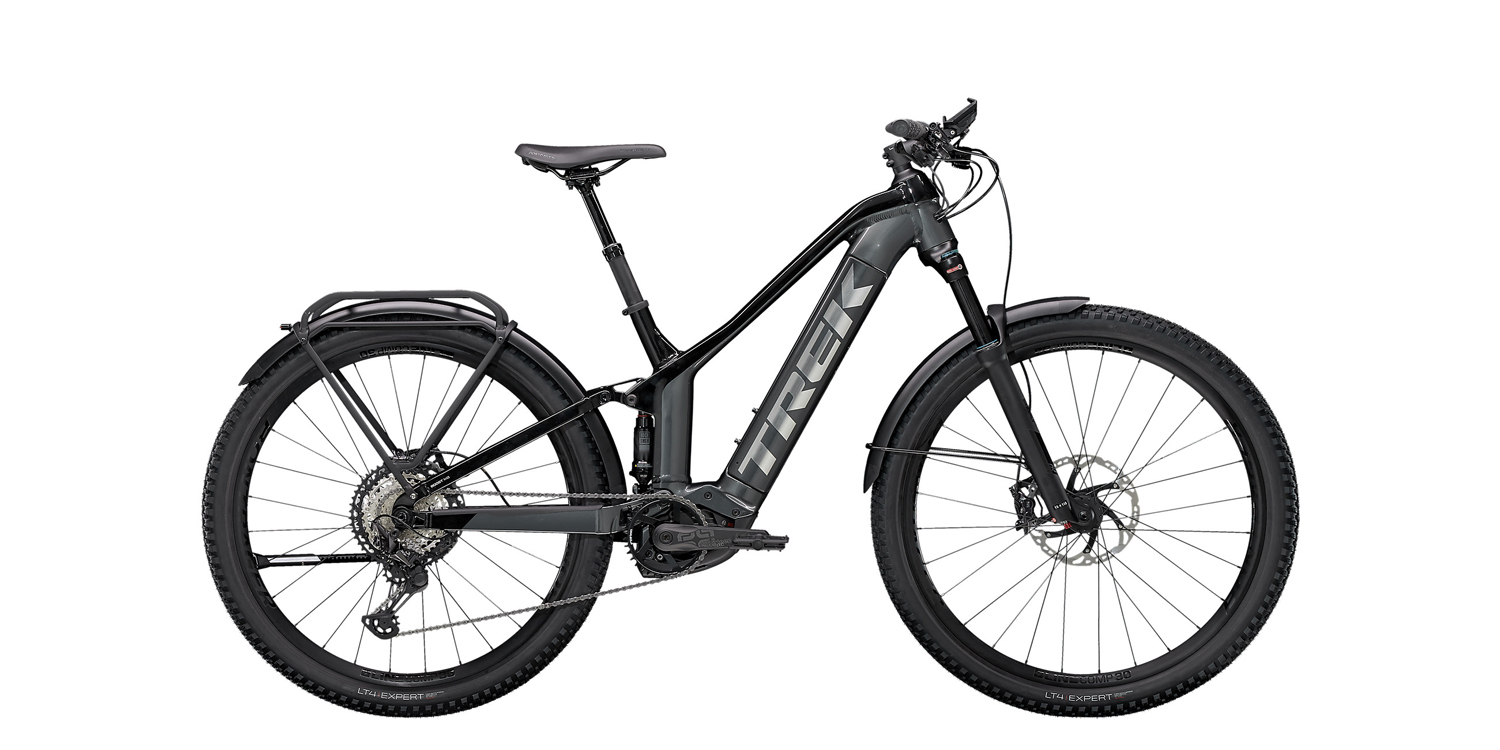
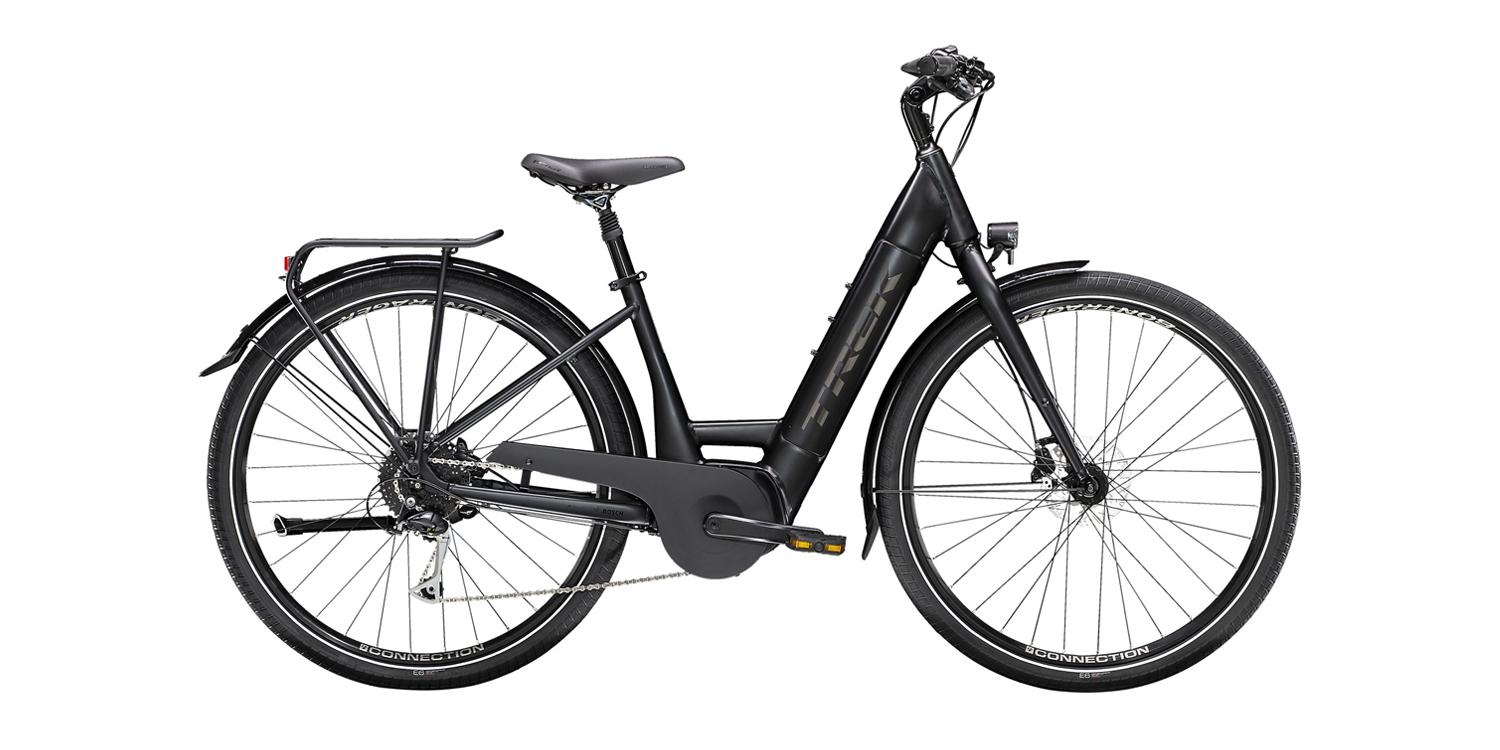
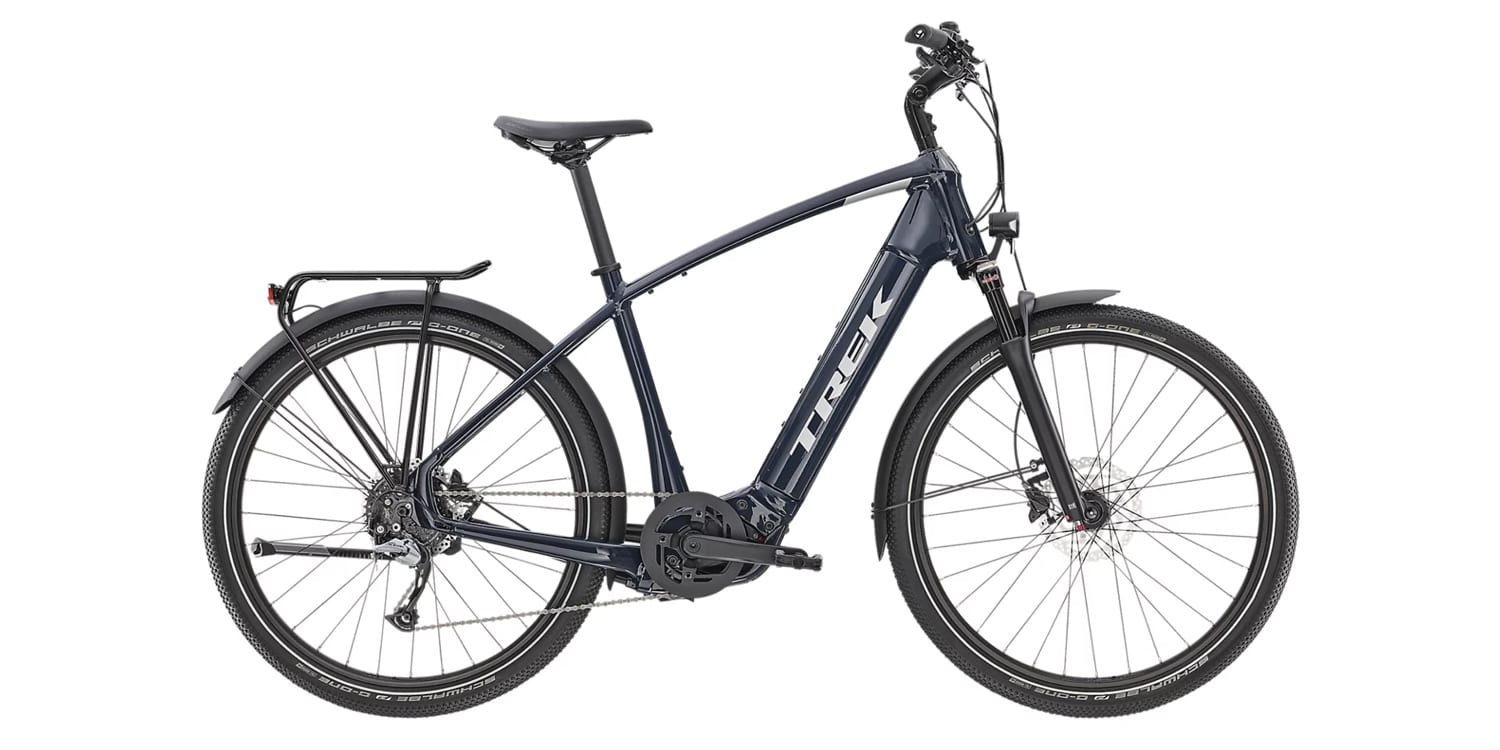
Synde says
Very nice review. As a short rider I am thrilled that they are offering an XS, and that they have reduced the wheel size for the XS and S. I recently bought a Levo XS, which comes with the 29 inch wheels. It would be a better overall fit if they used smaller tires. It’s nice to see a “do everything bike”. But the overall weight of this bike is to high for me. Thanks for the review.
Court says
Hey, you’re welcome Synde. It’s nice to read thoughtful feedback from someone who has tried a couple of bikes and actually benefits from the different geometry decisions that these companies are making. Yeah, the weight is a deal killer for many people. My Mom was really focused on this when we bought her bike, and she’s happy that she got a carbon fiber frame because she can lift it onto her bike rack more easily :)
Julian says
Can you take off the fenders and rear rack for offroad riding? Is this just a few screws, or more work?
Court says
Hi Julian! Yes, I am almost certain that you can easily remove the fenders and rack. The one caveat is that you probably have to remove both simultaneously. I think that they rely on each other for structural support.
David Bannister says
Great review as always. I have a Trek Verve + 3 low step that I find I am riding more off road than on. I have added ShockStop stem and seat post, removed the chain guard, put Marathon GT 365 tires on, and generally made it more trail friendly while being still a good commuter bike.
I am interested in the Powerfly FS 4 version of this bike in the XS frame as the low stand-over and dropper seat post are appealing… more flexibility, climbing ability and shock absorbing when I get off road. Keeping the Verve, I wouldn’t need the lights, fenders, cargo capacity, etc. At 65, my bones could sometimes use the extra suspension.
Looked at it today at my local Trek dealer, and it is a beautiful bike. Noisier than mine and with less range, but I seldom push that limit anyway. Seriously tempted… how to convince my other half?
Court says
Hey, I feel ya… these products can get pretty expensive ;) the thing is, they keep you fit and healthy (which extends your bodies age/range) and are social. I tend to be willing to spend more on life enhancing things like this, and my girlfriend is supportive because she wants me to last. Hope this helps, David :D
David Bannister says
Thanks Court… my wife is definitely supportive of my riding (at least at the single bike level) because the health and weight loss benefits have been obvious in six months. I have put 5400 km on the Verve since beginning of July… almost enough to equal Halifax to Vancouver.
Court says
Wow! That’s pretty awesome, David. Next time you want to ride that far, give me a ring and we can meet up in Vancouver where I live :D
MAC says
Very good and thorough review. I’m 47 and currently commuting on the Dual Sport 4. My daily ride to/from is about 10 miles, but I’m moving and my new commute will be 20 miles to/from.
I want an e-bike, and I really like Trek due to serviceability and quality, but I am torn between getting this Powerfly 9 FS Equipped and the Allant 7S. I am also considering the RAIL series bikes with a detachable rear rack. Price is not a concern and I do have a few MTB trails I can ride. What would you recommend? Do you have any reviews of rear detachable racks?
Thanks
Court says
Hi MAC! The Rail models look pretty sweet. No, I don’t have a review of the rack… but I do trust Trek with their bikes and accessories (often labeled Bontrager). For me personally (as a 37 year old with back, neck, and knee sensitivity), I almost always go for comfort. Full suspension feels great, but limits your rack options unless you get a seatpost clamp rack (which can get bumped out of place). The next best option would be a lightweight hardtail with a good rear rack and a suspension seat post :)
Richard says
Great looking trek bike and was tempted to get but i think the Bosch cobi smart hub for your phone could be a potential problem if you have got a expensive smart phone which isn’t waterproof as you would need to by a waterproof case to put your phone in to protect it from the rain etc but you would also have to be careful the phone might fall out of the holder if this fails at any point and potentially damaging your phone i would swap it over for the Bosch intuvia ,kiox, nyon rather than the cobi as fitted i am now looking at a Trek Rail 9.8 ,9.9 mtb great reviews as always much appreciated.
Court says
Hi Richard, yeah… I agree with you here. In addition to water damage and drops, there is also the heat and UV damage of direct sunlight on smartphone screens. I believe that this can be hard on them. I would probably lean towards the Kiox or Intuvia myself :)
thisbikeguy says
I just got word, the updated version of this comes with a Kiox 300 and will be available in a few months :)
Court says
Awesome! Thanks for the update :D